

Sail GP: how do supercharged racing yachts go so fast? An engineer explains
Head of Engineering, Warsash School of Maritime Science and Engineering, Solent University
Disclosure statement
Jonathan Ridley does not work for, consult, own shares in or receive funding from any company or organisation that would benefit from this article, and has disclosed no relevant affiliations beyond their academic appointment.
View all partners
Sailing used to be considered as a rather sedate pastime. But in the past few years, the world of yacht racing has been revolutionised by the arrival of hydrofoil-supported catamarans, known as “foilers”. These vessels, more akin to high-performance aircraft than yachts, combine the laws of aerodynamics and hydrodynamics to create vessels capable of speeds of up to 50 knots, which is far faster than the wind propelling them.
An F50 catamaran preparing for the Sail GP series recently even broke this barrier, reaching an incredible speed of 50.22 knots (57.8mph) purely powered by the wind. This was achieved in a wind of just 19.3 knots (22.2mph). F50s are 15-metre-long, 8.8-metre-wide hydrofoil catamarans propelled by rigid sails and capable of such astounding speeds that Sail GP has been called the “ Formula One of sailing ”. How are these yachts able to go so fast? The answer lies in some simple fluid dynamics.
As a vessel’s hull moves through the water, there are two primary physical mechanisms that create drag and slow the vessel down. To build a faster boat you have to find ways to overcome the drag force.
The first mechanism is friction. As the water flows past the hull, a microscopic layer of water is effectively attached to the hull and is pulled along with the yacht. A second layer of water then attaches to the first layer, and the sliding or shearing between them creates friction.
On the outside of this is a third layer, which slides over the inner layers creating more friction, and so on. Together, these layers are known as the boundary layer – and it’s the shearing of the boundary layer’s molecules against each other that creates frictional drag.
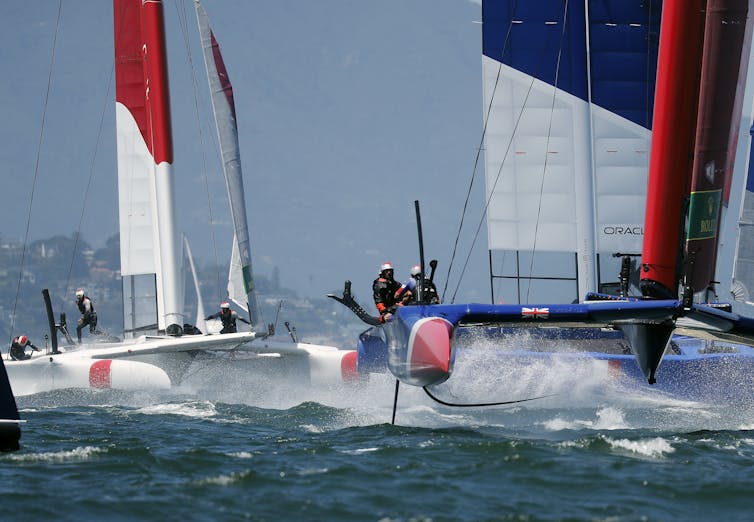
A yacht also makes waves as it pushes the water around and under the hull from the bow (front) to the stern (back) of the boat. The waves form two distinctive patterns around the yacht (one at each end), known as Kelvin Wave patterns.
These waves, which move at the same speed as the yacht, are very energetic. This creates drag on the boat known as the wave-making drag, which is responsible for around 90% of the total drag. As the yacht accelerates to faster speeds (close to the “hull speed”, explained later), these waves get higher and longer.
These two effects combine to produce a phenomenon known as “ hull speed ”, which is the fastest the boat can travel – and in conventional single-hull yachts it is very slow. A single-hull yacht of the same size as the F50 has a hull speed of around 12 mph.
However, it’s possible to reduce both the frictional and wave-making drag and overcome this hull-speed limit by building a yacht with hydrofoils . Hydrofoils are small, underwater wings. These act in the same way as an aircraft wing, creating a lift force which acts against gravity, lifting our yacht upwards so that the hull is clear of the water.
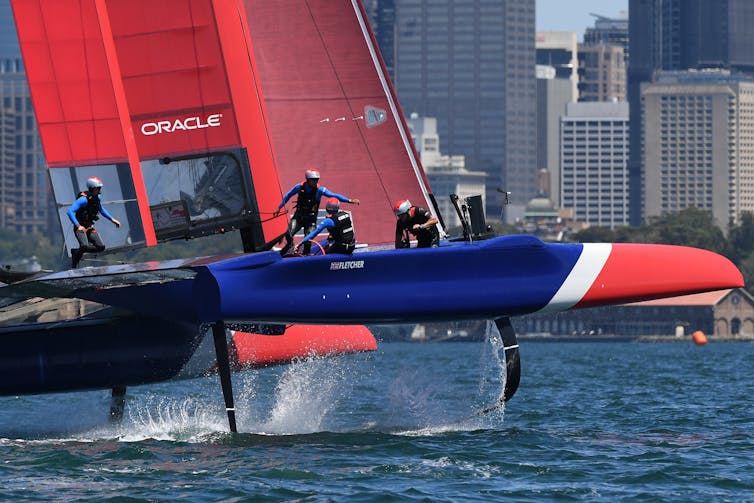
While an aircraft’s wings are very large, the high density of water compared to air means that we only need very small hydrofoils to produce a lot of the important lift force. A hydrofoil just the size of three A3 sheets of paper, when moving at just 10 mph, can produce enough lift to pick up a large person.
This significantly reduces the surface area and the volume of the boat that is underwater, which cuts the frictional drag and the wave-making drag, respectively. The combined effect is a reduction in the overall drag to a fraction of its original amount, so that the yacht is capable of sailing much faster than it could without hydrofoils.
The other innovation that helps boost the speed of racing yachts is the use of rigid sails . The power available from traditional sails to drive the boat forward is relatively small, limited by the fact that the sail’s forces have to act in equilibrium with a range of other forces, and that fabric sails do not make an ideal shape for creating power. Rigid sails, which are very similar in design to an aircraft wing, form a much more efficient shape than traditional sails, effectively giving the yacht a larger engine and more power.
As the yacht accelerates from the driving force of these sails, it experiences what is known as “ apparent wind ”. Imagine a completely calm day, with no wind. As you walk, you experience a breeze in your face at the same speed that you are walking. If there was a wind blowing too, you would feel a mixture of the real (or “true” wind) and the breeze you have generated.
The two together form the apparent wind, which can be faster than the true wind. If there is enough true wind combined with this apparent wind, then significant force and power can be generated from the sail to propel the yacht, so it can easily sail faster than the wind speed itself.
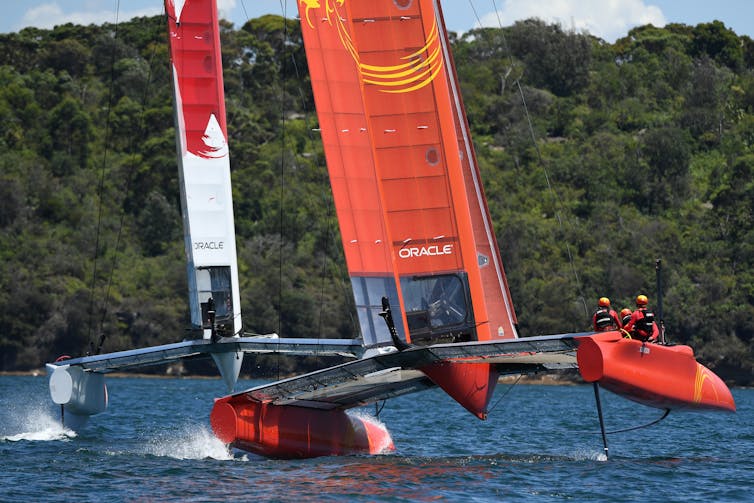
The combined effect of reducing the drag and increasing the driving power results in a yacht that is far faster than those of even a few years ago. But all of this would not be possible without one further advance: materials. In order to be able to “fly”, the yacht must have a low mass, and the hydrofoil itself must be very strong. To achieve the required mass, strength and rigidity using traditional boat-building materials such as wood or aluminium would be very difficult.
This is where modern advanced composite materials such as carbon fibre come in. Production techniques optimising weight, rigidity and strength allow the production of structures that are strong and light enough to produce incredible yachts like the F50.
The engineers who design these high-performance boats (known as naval architects ) are always looking to use new materials and science to get an optimum design. In theory, the F50 should be able to go even faster.
- Engineering
- Aerodynamics

Deputy Editor - Technology

Sydney Horizon Educators (Identified)

Assistant Grants Officer

Deputy Vice-Chancellor (Academic and Student Life)

Visiting Professor - 2024-25 Australia-Korea Chair in Australian Studies at Seoul National University
How the world’s fastest sail racing boats fly above the water

Tune in to SailGP Season 2 and you’d be forgiven for thinking that your eyes are deceiving you.
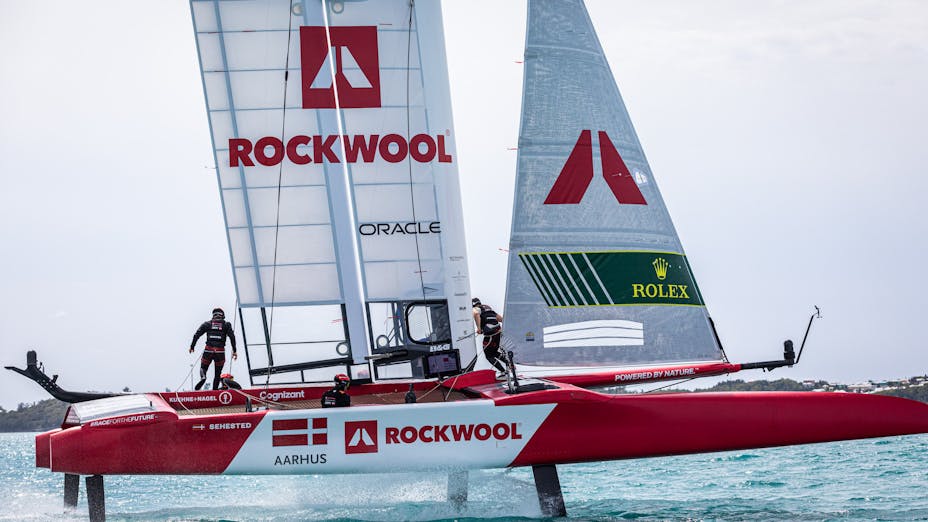
So, what is foiling, how does it work, and when did sailing become so… cool?

It's all about drag

The story behind hydrofoils
The next frontier.

Beneath The Surface
Watch on youtube.
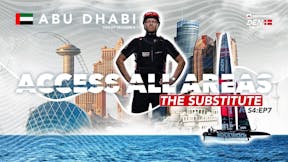
Access All Areas
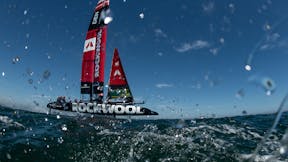
Want to learn more about SailGP?
Meet the denmark sailgp team, find all the latest news, go beneath the surface of sailgp, discover more beneath the surface.

Protecting paradise – Sailing towards a more sustainable future

Chasing a dream – Risking everything to renovate an abandoned hotel

The Beneath The Surface show
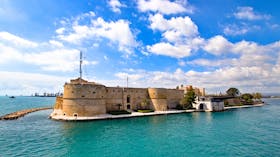
Helping Taranto sail towards a brighter horizon

ROCKWOOL Group
Yachting World
- Digital Edition

Fastest yacht: The giant record breakers
- Toby Heppell
- October 29, 2021
Skorpios is the latest in a long list of giant monohulls designed with a view to becoming the fastest yacht on the planet. We take a look at some of her predecessors

Every so often the yacht racing world sees an ambitious owner with pockets deep enough to want to step things up a gear and produce a new record-smashing fastest yacht.
The latest of these to hit the water is the jaw-dropping ClubSwan 125 Skorpios built for its Russian owner, Dmitry Rybolovlev. Almost everything about this new monster yacht is bigger, stronger, faster and higher tech than any boat which came before it.
Pretty much any metric you care to look at on Skorpios is mind-boggling. The five-spreader Southern Spars mast stands at 175 feet tall, and she can carry 11,324 square feet of sail upwind, and 21,108 square feet downwind.

Enough sail? Skorpios off the Dorset coast. The ClubSwan 125 is named after owner Rybolovlev’s famous Greek island, where Jackie Kennedy married Aristotle Onassis. Photo: Mark Lloyd / Lloyd Images
Skorpios has been built with the express brief to break offshore records as the world’s fastest yacht. Her recent win in the 2021 Fastnet Race – only weeks after hitting the water for the first time – shows she certainly has what it takes to take line honours in big races.
And the numbers Skorpios has shown while racing initially seem to indicate that it is really only a matter of time until she starts claiming some of the biggest records on offer in the sailing world.
But Skorpios is only the latest in a long line of new yachts built with the express purpose of winning line honours and taking records, each bigger, faster and more technologically advanced than that which came before.
The current transatlantic record holder, Comanche , is probably the yacht that most readily springs to mind when we’re looking at the development path for Skorpios .
Before Skorpios , Comanche was the most recent, highly ambitious racing yacht on the planet. She was built with one thing in mind and one thing only, to break ocean records and win line honours in some of the world’s most famous races.
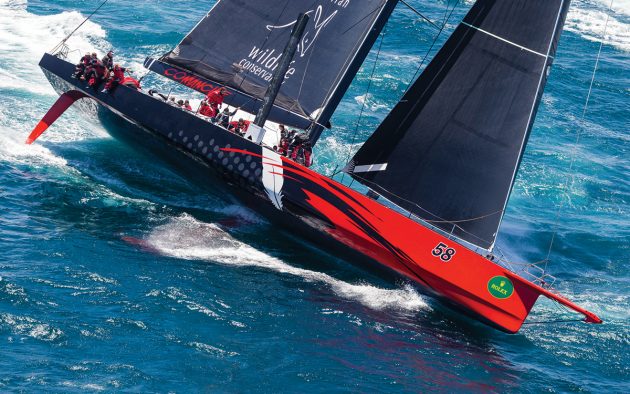
Comanche showing off her considerable beam. Photo: Carlo Borlenghi
“The design office were told specifically by me that if this boat wasn’t the worst rated boat in history they have failed,” stated the owner Jim Clark on Maxi, Comanche ’s launch, reaffirming the aim of the boat to break records and win line honours without any consideration for handicap wins.
Comanche was something of a revelation when she was first launched. Over the years boats had been carrying more beam (width) towards the transom to create more power – at the expense of outright light weather, upwind and VMG running performance.
Comanche took this line of thought to the extreme with what seemed an impossibly wide stern, which led to the boat being nicknamed the aircraft carrier.
Although Skorpios is technically beamier than Comanche (8.75m vs 7.85m) the ClubSwan’s hull shape has a more modest beam-to-length ratio, and far greater internal volume and higher freeboard, all products of the project starting out with some focus on cruising in addition to outright performance.
But despite a slightly less powerful hull shape compared to Comanche , when you look at the rig, you see that this will likely be overcome by sheer grunt in terms of sail area. Skorpios ’ mainsail alone is 7,093 square feet, compared to Comanche ’s 4,413 square feet.
Comanche was, indeed is, a yacht that pushed technology to the absolute limit and when she was launched her extreme design caused quite a stir.
She is still considered one of the fastest yachts on the face of the earth and, in addition to her transatlantic record, Comanche also holds the monohull 24 hour sailing record at an impressive 618.01nm (averaging 25.75 knots) in a 24 hour period.
These two records will almost certainly be two of the key prize scalps Skorpios will be hoping to take.
Mari Cha IV
Although for many Comanche is the most obvious boat to which Skorpios can be compared, arguably a closer comparison could be that of Mari Cha IV , particularly when you consider length and ambition to break oceanic records.
The 140ft Mari Cha IV was launched in 2003, at this size both Mari Cha IV and (140ft) Skorpios face a similar problem, there are several top races that have an upper LOA limit of 100ft – neither could take part in the Sydney Hobart race for example.

Mari-Cha IV held the Atlantic record for 12 years. Photo: Thierry Martinez
In 2003, Mari-Cha IV set a new west-east transatlantic record with a total time of 6 days, 17 hours. During the run, she also set a new 24 hour monohull distance record of 525.5 nautical miles . This record stood until Comanche snatched the crown in 2016.
Due to her size and the sail area needed to power the giant, Mari Cha IV was built as a two-masted schooner. This meant that each mast could be smaller – within the bounds of the technology available at the time.
The twin rig on Mari Cha IV also meant each of the sails could be smaller than would be needed on a single masted yacht, reducing loads and enabling the boat to be sailed without resorting to powered winches.
That Skorpios is a single masted 140 footer demonstrates two things. The ClubSwan 125 shows the advances in technology with a single 175ft mast now being much more easily managed and understood – thanks, in no small part to advancements in load sensing technology which have filtered down from the America’s Cup and high tech offshore yachts such as the Ultime trimaran and IMOCA 60 fleets.
However, sail handling for sails of the size needed on Skorpios is still an issue and the ClubSwan 125 still needs powered winches, which will put her out of contention for a number of records that require exclusively human power.
In 2008, Speedboat was launched . The Juan Kouyoumdjian -designed 100ft Maxi was a yacht designed to produce blistering speeds and was built with the express purpose of ocean record breaking.

Speedboat , Newport Bermuda Race 2010
The yacht was built by Mick Cookson at Cookson Boats in New Zealand and her radical underwater features, including an incredibly flat run aft were all features that would later be included in the design of Comanche – features that demonstrate a yacht built for record breaking as they offer serious compromises in lighter winds.
In many respects Speedboat was the first to take the wide flat hull concept and transplant it wholesale into a 100ft Maxi.
Speedboat was also the first Maxi to have a deck-stepped rig, which was produced by Southern Spars, and she has plenty of other radical features.
To an extent Speedboat was built as a scaled up version of the Volvo 70 ’s which had been impressing in the Volvo Ocean Race . As such it is hardly a surprise the boat was the product of Kouyoumdjian’s design house, as he had created several of the fastest Volvo 70s then racing.
Unfortunately Speedboat arrived at the very start of the financial crisis and she only sailed in a number of events before she was mothballed and eventually sold.
She went through a couple of incarnations before being purchased by George David and was sailed as Rambler 100 during which time she dramatically lost her keel and capsized while competing in the Fastnet Race .
For his part David would go on to commission Kouyoumdjian to draw Rambler 88 , an impressive bit of kit in its own right and aimed at winning line honours and races outright in an 88ft package.
Wild Oats XI
No list of record breakers and record holders would be complete without a mention of Wild Oats XI , the 100 ft Maxi belonging to the Oatley family, which has won the Sydney Hobart no less than seven times.
Wild Oats XI ( WOXI for short) was actually launched back in 2005 and is a prime example of what can be done to a yacht to keep her on pace with current trends and developments.
In 2009 she was lengthened at bow and stern from 98ft to 100ft. In 2011 her forward balanced spade canard was removed and twin daggerboards were added amidships. In 2012 she received a bow centreboard as well as caudal fin winglets on her torpedo bulb.

Wild Oats XI . Photo: Kurt Arigo / Rolex
In 2013 she was equipped with a Dynamic Stability System (DSS) foil, which is a retractable horizontal foil deployed on the leeward side of the boat.
In 2015 her stern was shortened by 2m and her 12m forward sections were replaced by a 14m longer, sleeker bow, keeping her midship sections unmodified and in effect moving her entire existing sailplan aft by 2m, a trend which had been seen in many of the newer maxis to be produced since.
The various appendages which have been added and removed over the years have lent the yacht the affectionate nickname the ‘Swiss army knife’.
By today’s standards WOXI remains a very skinny boat in the Maxi world – she and almost-sistership at the time of launch, Alfa Romeo II both had a max beam of a little over 5m.
Wild Oats XI remains a potent race boat and particularly for races like the Sydney Hobart, her relatively narrow beam gives her an edge in light winds, VMG running and beating, all of which mean she is still very hard to beat over a race with mixed conditions – if ultimately working against her should she ever look to set oceanic records.
Leopard 3 ( ICAP Leopard as she was launched) hit the water in 2007 for serial Maxi owner, Mike Slade. The Farr design had a number of unique features at the time of launch, which made her one of the most impressive superyachts on the circuit.

ICAP Round Britain and Ireland Race 2010
Leopard ’s mast was a towering 154ft and she could set a total downwind sail area of 17,265 sq ft. At the time this was a vast amount of sail – though Skorpios ’ 21,108 sq ft is something of a stark comparison.
Leopard is capable of speeds of over 35 knots. But her similarities to Skorpios actually centre around the plans the British boat had from the start to enable cruising and racing in a little more comfort.
Leopard featured a luxurious removable interior, which could be removed for racing and refitted for cruising or for charter – for which she had also been specifically designed and built.
Although Skorpios does not go quite as far as a fully removable interior, there is, at least, a nod to comfort in her design when compared to the out and out racer that is Comanche .
If you enjoyed this….
Yachting World is the world’s leading magazine for bluewater cruisers and offshore sailors. Every month we have inspirational adventures and practical features to help you realise your sailing dreams. Build your knowledge with a subscription delivered to your door. See our latest offers and save at least 30% off the cover price.
Jump to navigation
Search form
- Crew Finder
- Century Club
- Start Sailing Now
- Racing Team
- See The Bay
- Boats For Sale
- Boat Reviews
- Classifieds
Sailboat Racing Tips: Speed Through Kindness
Posted February 20, 2024
Where Kindness May Be Your Most Strategic Sailboat Racing Strategy
The overall objective in sailboat racing is to cross the finish line first—to sail the course faster than your competitors. While there are endless decisions to make toward achieving that goal, simply sailing fast is a (and sometimes, the) primary key to success.
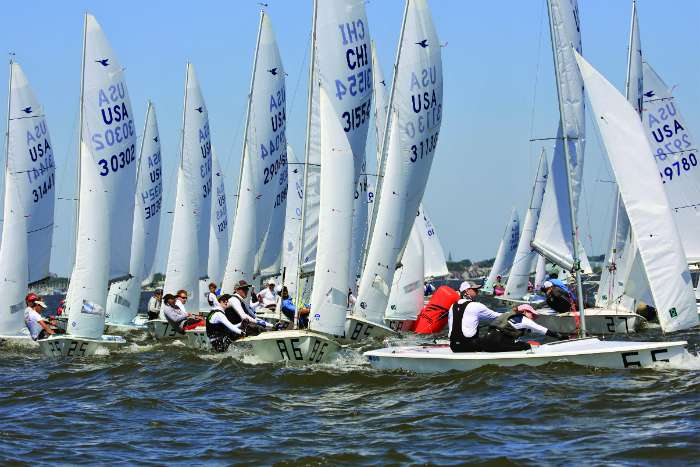
Sailboat racing is also supposed to be fun. Being tangled up with other boats, or being distracted by what’s going on around you, isn’t fun or fast.
What does “tangled up” mean here? It can be literal or figurative; from getting your shrouds meshed with another boat to a little bumper boat action to getting yourself in bad air, tangled is slow. Distractions are slow, whether it’s something that draws your focus away from driving fast or if it’s thinking about how you’re going to write up that protest form from the situation that just happened.
You can often avoid getting tangled up or distracted by being kind to your competitors. There are a few spots on the racecourse where the benefits of being kind to other boats can pay off not only for them but for you as well.
Before, during, and just after your start is a critical time where you need to focus on getting your boat off the line. It’s not where you are right at the start but 30 seconds after the start! Are you able to start with fairly clean air and a lane you can keep going in for a bit? That’s the goal. Yes, sometimes when you’re on final approach to the line, you need to do a bit of squeezing in to get your spot. But rarely do you need to screw someone else to do that. Swooping in from up the line or tacking super tight to leeward of a boat already set up on starboard makes them alter course and also restricts your maneuverability.
Remember Racing Rules of Sailing #16, which notes that a right-of-way boat must give the other boat room to keep clear—so that if you come in to a starting line too close to leeward to another boat, and as they pivot and try to head up to keep clear of you, the back hip of their boat hits your windward side, there’s a good chance you didn’t give them enough room. And then, they are possibly on your air (not good for you getting rolling fast as the starting gun fires), and you may have some time in the protest room ahead of you (a short- and long-term distraction). The alternative? Be a little kind, give them a little more room, and everyone’s happy.
Mark roundings are another classic part of the racecourse where kindness can help you get around the course more quickly. Coming in near the weather mark on port tack, there’s a starboard tack boat you could either cross or plant a tight lee bow on, maybe on layline but maybe not? Crossing them and tacking above them not only lets them keep on trucking, but also means you don’t have to pinch (= slow) your way to the weather mark. True, they might round the weather mark before you, but you’ll be tight on their tail and on their breeze, ready to pass them downwind.
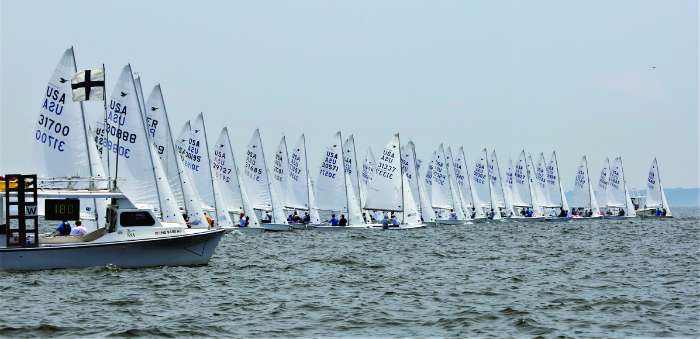
The leeward mark is also a great spot where being kind and slowing down and letting the boats that are in front of you stay in front of you (for the time being!) can ensure greater success. Yes, of course, it would be super to have amazing boat speed and choose your positioning as you’re working down the leeward leg to get solidly overlapped inside so that you get to round that leeward mark or gate ahead of the folks you’re grappling with. But if it’s touch-and-go and you’ve only recently moved into a position where you might have a sketchy overlap, remember: RRS 18.2(e) says that if there’s a reasonable doubt that a boat obtained or broke an overlap in time, it shall be presumed that she did not.
But never fear, having to follow another boat around the leeward mark isn’t the end of the world. Far from it. If you see that situation developing, think three steps ahead to how you want to be sailing once you have rounded the mark. I’m guessing that “having rounded outside them, sailing in lower and in their dirty air” isn’t your goal! If you step on the virtual brake pedal a bit, you can set yourself up for a much better rounding by following their transom around rather than actually being outside them. Take down your spinnaker and put your centerboard down early; overtrim your main. Being kind to the other boat by not forcing yourself into a bad rounding will position you for success!
There are lots of other situations where giving other boats a little breathing room is kind to them—and potentially even more beneficial to you. Seek out those opportunities!
About the Author: SpinSheet Small Boat columnist for more than a dozen years, Kim Couranz has earned several national and world titles in Laser Radials (ILCA 6), Snipes, and Lightnings. She has also raced J/22s, J/24s, and Ynglings on an international level.

- Privacy Policy
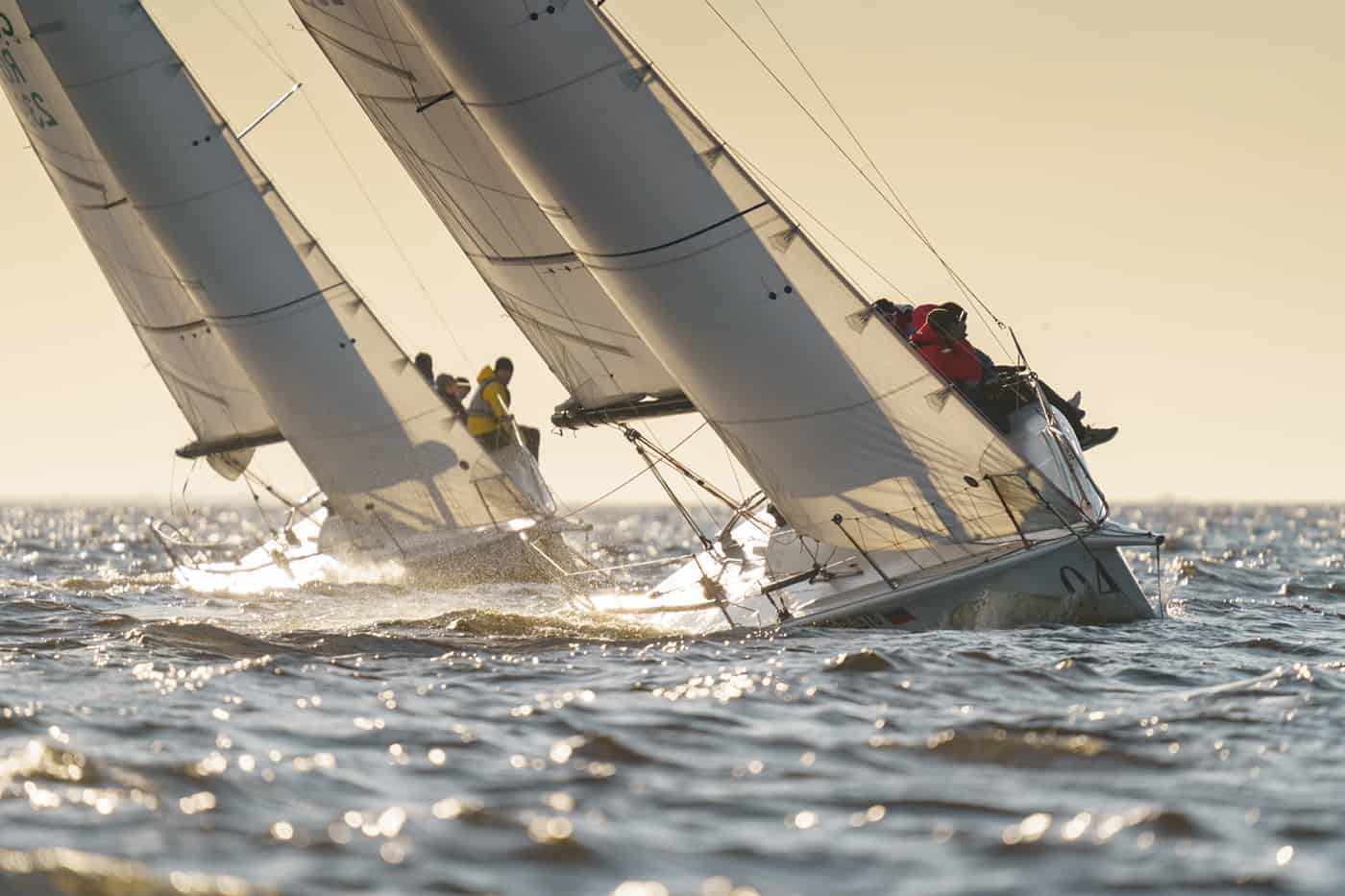
How Fast Can A Sailboat Go? FAQ
Welcome aboard, sailing enthusiasts! Have you ever wondered how fast a sailboat can glide through the water? In this blog post, we’ll dive into the thrilling world of sailboat speeds and explore the factors that influence their pace.
Let’s have a look…
How Fast Can A Sailboat Go – The Facts
What is the average speed of a sailboat, can a sailboat go faster than the wind.
- What Is The Fastest Type Of Sailboat?
How Fast Do Race Sailing Boats Go?
How fast can a sailboat go – summary.
Sailboat speeds can vary based on their purpose and size.
Most sailboats typically travel at speeds of 4-6 knots (4.5-7 mph), with the top speed reaching up to 7 knots (8 mph).
Larger sailboats can go even faster, reaching speeds of up to 15 knots (17 mph or 28 km/h). Speeds of over 8 knots in sailboats are not common, and the actual speed may slightly differ based on the type of sailboat and wind conditions.
Racing sailboats, which can achieve between 8 to 20 knots (9 to 23 mph), or even faster, are specially designed for higher speeds compared to bulkier ones.
Those are the facts. Now, let’s address some of the most frequently asked questions.
Sailboat Speed FAQ
A classic cruising sailboat has an average speed of 4-6 knots, but it can reach the maximum speed of 7 knots. The average speed in a racing sailboat is 15 knots; one knot equals 1.15 mph. The ability of sailboats to go fast mainly depends on how it harmonizes between their length and the power driving them. Size and length are the main determinants of speed aside from currents and wind. That is why a shorter boat will have low speed than a longer one. The shape of the hull is also a significant contributor to the speed of the sailboat.
A sailboat can outrace the wind; most of them can. Given the right conditions, the sailboat will catch most parts of the wind and send the energy to the hull. That will drive the vessel at high speed. Racing sailboats are sleek and very fast and can go three times the speed of the wind. Because wind is the only thing that powers these sailboats, it might seem like they are going against natural laws. But the fact is they harness two types of wind, the prevailing natural wind and the apparent wind. Apparent wind is the one that comes when an object is in motion, and sailboats utilize both.
What Is The Fastest Type Of Sailboat?
The fastest sailboat in the world is a monohull needle-nosed racer. It’s called V.O.60 and can attain a maximum speed of 36 knots (41.4 mph). The vessel is 64 feet long and over 17 feet wide and weighs thirty thousand pounds. As you already know, several factors determine the speed of a sailboat. When everything comes together perfectly, the boat can break records in terms of speed. The fastest sailboat has the equipment’s weight concentrated on the hull’s centre. The hull and deck also have to be very clean to minimize any resistance. However, there have been faster sailboats than this over the years.
Race sailing boats go up to 15-20 knots (17-23mph). That is an average racing sailboat, but there has been dramatic speed recorded over the past few years. Racers go all out to win by getting the best vessels money can buy. That is not the only thing that will determine the winner and achieving top speed. Everything has to play its part, from the hull to the racing sailboat’s length and size. Race sailing boats are the ones that have recorded the fastest speeds than regular sailboats.
A sailboat can go as fast as 20 knots, but the average speed of a sailboat is 4-6 knots.
The fastest sailboat is V.0.60 monohull with a speed of 36 knots.
A sailboat can go as fast as the wind or even faster under the right conditions.
A race sailboat can go at a speed of 15-20 knots if it’s a standard one.
There have been exceptional race sailboats with very high maximum speed.
Disclaimers
All product names, logos, and brands are property of their respective owners. All company, product and service names used in this website are for identification purposes only. Use of these names, logos, and brands does not imply endorsement.
It is our policy to make every effort to respect the copyrights of outside parties. If you believe that your copyright has been misused, please provide us with a message stating your position and we will endeavor to correct any misuse immediately.
Some of the links in this post are affiliate links. As an Amazon Associate, we earn from qualifying purchases. This means if you click on the link and purchase the item, we may receive an affiliate commission, at no extra cost to you. This helps us keep this website alive. Learn more here .

Hi, I’m Igor, Skipper of S/Y "The Hooker". A decade ago, I conquered my childhood dream: to be a sailing skipper, own a sailing yacht. Yes, it knocked dullness out of my urban life — Read more →
Leave a Reply Cancel Reply
Your email address will not be published. Required fields are marked *
Name *
Email *
Add Comment *
Save my name, email, and website in this browser for the next time I comment.
Post Comment
Related Posts

How Does the Effect of Alcohol While Boating Compare to Its Effect While on Land
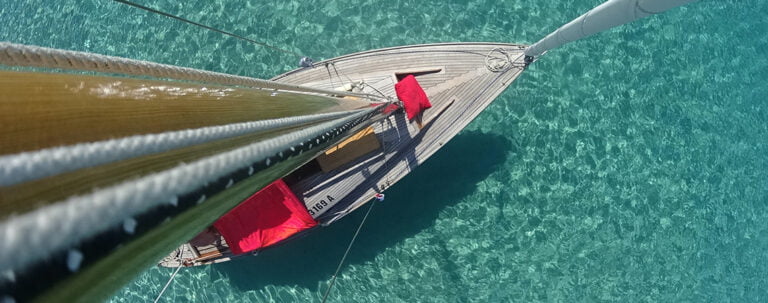
Know Your Directions on Board a Ship
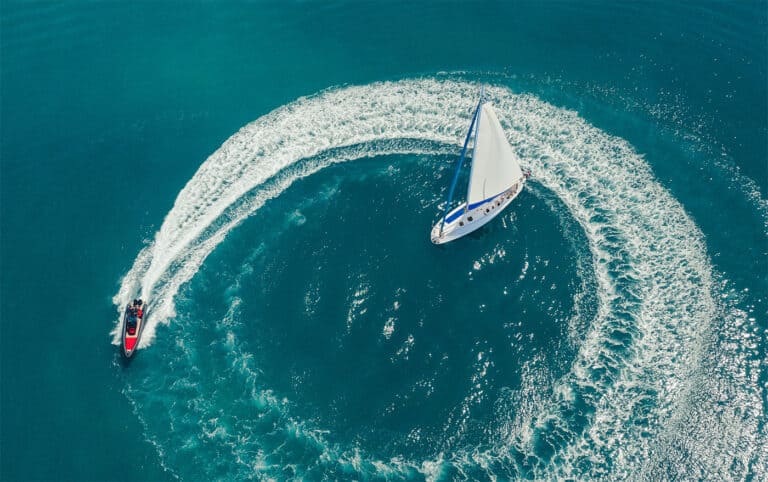
A Sailboat Under Sail Is About To Cross Paths With A PWC. What Action Should Be Taken?
Amazon Disclosure
DesperateSailors.com is a participant in the Amazon Services LLC Associates Program, an affiliate advertising program designed to provide a means for sites to earn advertising fees by advertising and linking to Amazon.com. As an Amazon Associate, we earn from qualifying purchases. Amazon and the Amazon logo are trademarks of Amazon.com, Inc., or its affiliates.
Please refer to our Privacy & Affiliate policy for more details.

- Find A School
- Certifications
- North U Sail Trim
- Inside Sailing with Peter Isler
- Docking Made Easy
- Study Quizzes
- Bite-sized Lessons
- Fun Quizzes
- Sailing Challenge

How to Start a Sailing Race Effectively
By: Zeke Quezada, ASA American Sailing , North U
My journey to becoming a sailboat racer is evolving. In the past few months, I have become acquainted with racing terms, phrases and the sailboat racing rules. I have begun browsing clinics, seminars, and webinars in American Sailing’s North U curriculum. I sailed out on a Wednesday night to watch the local racers get started on their weekly races. Shockingly, I have even begun to play with trimming the sails!
I have evolved.
I see other boats in the marina and have an internal conversation about how I would beat them in an imaginary race. Geometry, weather prediction, and my boat’s performance are no longer taken into consideration just to get me back to the dock before happy hour ends. I am now trying to become an efficient sailor.
Could my first race be on the horizon?
Let’s let out the main for a moment and slow this thing down. I need more knowledge. I need to know how to start a sailing race.
Starting Tactics for Sailboat Racers
When it comes to racing, mastering effective starting tactics is crucial for a successful race. However, it’s important to recognize that starting tactics can vary depending on factors such as the specific race, wind conditions, and the rules of the event. It’s a dynamic aspect of sailing that requires adaptability and strategy.
The Value of Observation
One valuable approach to improving your starting techniques is observing other sailors. By attentively watching experienced sailors in action, you can gain insights into their strategies and learn from their successes and mistakes. This observational learning can provide valuable knowledge and inspiration for refining your own starting tactics.
Gain Crewing Experience
Gaining practical experience through regular practice and participation in races is key to honing your starting skills. Each race presents a unique set of challenges and conditions, allowing you to test and develop your techniques. Learning from your own experiences, analyzing what works well for you, and making adjustments along the way will contribute to your growth as a competitive sailor.

Embrace the Process
Starting a race effectively is a skill that evolves over time. Embrace the learning process, stay open to new strategies, and continue to refine your starting tactics based on the dynamic nature of each race you encounter.
Six Ways to Improve Race Starts
Starting a race effectively can significantly impact your results. Here are six ways to improve your starts as instructed by Bill Gladstone of North U.
- Starts are chaos. If you’ve never been on a starting line before it is hard to prepare yourself for the seeming chaos that is a sailboat racing start. You’ll also need to get used to how crowded and close-quartered the line can be. Maneuvering within a few feet of other boats is an everyday occurrence for racing sailors and takes some getting used to.
- You need to have a plan. To make order out of the chaos you need to have a starting plan – and then you need to be ready to improvise on that plan as circumstances dictate. There are some standard approach plans – reach and reach, port tack approach, half speed – and positioning plans to choose from. Have a plan and share it. The whole team should know what the plan is. Do a dress rehearsal. It won’t be the same as the real thing but will give you a baseline to work from.
- Teamwork and efficient communications are key. There’s no time for explanations and discussion. Things happen fast. For example, we are always ready to tack; there’s no, “Ready about, Hard-a-lee.” It’s just, “Tacking.” Efficiently communicating the position and behavior of rival boats with clear simple terms is critical. Time is short.
- Don’t be late. It takes practice (and teamwork) to accelerate to full speed and hit the line on time – even when sailing alone. In the crowds and chaos of a start it is trickier still. Set up early and push to the line. If you are early you can waste time by oversteering to sail extra distance; but once you are late, you are late.
- Avoid crowds. You’ll hear plenty about starting at the favored end and all that. True enough. But more important is keeping clear enough of crowds that you can sail your boat and hit the line on time and at full speed. It doesn’t matter so much where you are on the line. Sail your boat and hit the line on time and at full speed.
- BONUS item: Clear Air. To sail full speed you need to be in clear air – clear of crowds. But wait – there’s more: Surprisingly, for an upwind start – and most starts are upwind – you should position yourself so there is plenty of room to leeward, under your jib. Having a boat close to windward is much less of a problem. Preserving room under (to leeward) of your bow will allow you to sail full speed coming off the line.
Once you are off the line, at full speed, in clear air, then you are racing… And most races are decided by speed. You’ve got to be fast to win. That’s a topic for another day.
If you encounter a boat in your marina starting and stopping and generally looking confused, that might be me. I am working on taking some of Bill’s advice, and will soon no longer be a spectator. Instead, I will be a racer!
Ready to get in the race? Take a look at this North U course on Racing Tactics .
Related Posts:

- Learn To Sail
- Mobile Apps
- Online Courses
- Upcoming Courses
- Sailor Resources
- ASA Log Book
- Bite Sized Lessons
- Knots Made Easy
- Catamaran Challenge
- Sailing Vacations
- Sailing Cruises
- Charter Resources
- International Proficiency Certificate
- Find A Charter
- All Articles
- Sailing Tips
- Sailing Terms
- Destinations
- Environmental
- Initiatives
- Instructor Resources
- Become An Instructor
- Become An ASA School
- Member / Instructor Login
- Affiliate Login

Introduction to Sailboat Racing [Rules and Classes Explained]
True, when you first witness a sailboat race, you might believe it’s too confusing and chaotic (it can be both). But, like with anything new, you may ease into it gradually. This is intended to allow you to take several actions at once.
Racing a sailboat is a lot of fun. It blends the excitement of sailing your own boat with the raw rivalry of trying to beat another boat of comparable size. Racing also teaches you boat handling and sail trim in a manner that cruising cannot: by comparing your speed and handling to those of other boats.
Let us jump into the article to learn more about sailboat racing.
![Introduction to Sailboat Racing [Rules and Classes Explained] 1 Sailing boat with two crew members participating in the sailboat racing](https://maritimepage.com/wp-content/uploads/2023/02/Sailboat-Racing-Rules-and-Classes-2-1024x683.webp)
Basic Insights Into Sailboat Racing
Sailboat racing may be separated into three parts: start , headwind , and tailwind . During a sailboat race, it is important to ensure that the beginning of the race must be strong. The start determines the overall outcome of the race and thus is considered very crucial for the race. It brings great advantage to the competitor and this is often very underrated.
As soon as the countdown is complete, it is necessary to make sure that the competitor has crossed the starting line effectively. Generally, warnings are given at 5mins and subsequently at 4mins and 1min .
Another very important aspect to consider is the path . The competitor must be able to determine a clear path to sail through and the direction of the race course must also be perceived correctly to ensure a favorable outcome. Free lanes enable the competitor with ideal angles to the wind with which they can easily navigate without having to go against disturbed wind or wind shadows from rival boats.
![Introduction to Sailboat Racing [Rules and Classes Explained] 2 Sailboat Racing Rules and Classes - Small sailboat racing](https://maritimepage.com/wp-content/uploads/2023/02/Sailboat-Racing-Rules-and-Classes-Small-sailboat-racing-1024x819.webp)
The Starting Line
Oftentimes, the first leg of the race will be upwind, after the starting line is crossed. At this point again, it is important to note that starting strong is crucial for an upwind race as more free lanes are accessible the further ahead the competitor is in the convoy.
The necessary determinants to be noted and kept in consideration throughout the race for effective upwind sailing strategies are the following factors: wind direction, wind speed, and rivals. But the last aspect can be tricky as everyone’s goal is ultimately to win.
Competitors need to base their choices for sailing downwind on the same findings, but with a few minor variations. Being at the forefront and tagged by rivals can be seen as a mode of suffering when the competitor must keep sailing in the wind shadows of all the boats behind. Here, there’s an advantage to be thought of if the competitor can position themselves at the rear. Any lane can be chosen at proper intervals to make up for the lost ground.
However, usually, down winds result in shorter wins and losses than up winds . This is because there is less transverse separation during down winds when compared to up winds.
![Introduction to Sailboat Racing [Rules and Classes Explained] 3 Sailboat Racing of the same class maneuvering near the start line](https://maritimepage.com/wp-content/uploads/2023/02/Sailboat-Racing-Rules-and-Classes-Dinghy-sailboat-racing-1024x683.webp)
Different Types of Sail Racing Classes
Sailboat racing can be done in different ways. Each race lasts for about 45min to 1hr and is conducted on a course marked by buoys mounted by the racing committee. One can also take part in “ distance races “. In this case, the “ natural ” surroundings will typically provide the race course.
The points of sail during the race depend on the predominant wind direction factors on the day of the race, which is the other major variation besides the length. While racing on the course, the race committee places the buoys in such a manner that the race course is adapted to the wind , this mostly enables the competitors to accurately identify which sail has to be deployed for the upcoming leg .
At the race course and during the distance races, the sailboats that participate are usually of various types and are commonly very diverse. As a result, the organizing committee frequently employs intricate “ handicap ” mechanisms to even out variations across boat types . The system is often country-based and it has been developed based on the most common types of boats in a country. The RC , ORC , and IRC systems are the most widely used on an international scale .
These systems compute a factor that should be multiplied by the exact time required to sail one nautical mile using complex formulas . They are based on the dimensions of the boat’s length, weight, sail size, types, and design of the boat along with the materials used .
To find the adjusted race time that can be used to compare with other competitors, this f actor is multiplied by the amount of time it took you to complete the race and the distance of the race .
It is very necessary to remember that these systems are not entirely accurate and they cannot be completely relied on. They can only be used to a certain extent for performance comparison . Hence it is advised that one must compete in races where the competing boats are similar to accurately assess the racing skills of the competitor.
![Introduction to Sailboat Racing [Rules and Classes Explained] 4 Sailboat Racing Rules and Classes](https://maritimepage.com/wp-content/uploads/2023/02/Sailboat-Racing-Rules-and-Classes-6-1024x683.webp)
Main Rules in Sailboat Racing
These races are administered and authorized by the International Racing Rules of Sailing . It lays down rules and safety measures to sail safely across the race course along with the entire fleet, whose goal is to sail successfully during the race as well.
A rulebook is laid down with fundamental rules providing explanations and specimens about ensuring how to maintain and regulate according to the laws during a variety of circumstances that can arise between competing sailboats during the course of the race.
The most fundamental rule is that vessels with their starboard side windward must give way to vessels with their port side windward . This implies that the port-tack boat must either tack or bear away to pass behind the stern of the starboard-tack boat when two boats on opposite tacks come together . The leeward boat always has the right of way over the windward boat when there are two boats on the same tack.
![Introduction to Sailboat Racing [Rules and Classes Explained] 5 YouTube player](https://i.ytimg.com/vi/y_Au4vEg-Aw/maxresdefault.jpg)
Although this is the case, it is essential to note that the boat with the right of way must always ensure to leave other sailboats adequate space and time to avoid collision and accidents . While trying to maintain contact with other competitors, one must be very safe and secure as a significant level of rule interpretation can be enforced.
Violation of any rule can cause you to self-forfeit from the race . Hence it is advised to make amends and surrender upon having committed a conscious foul. Most admitted fouls are looked over following a penalty turn of 360 degrees or 720 degrees . Sailing instructions can be seen as a guide in all circumstances to find more detailed information about the same. A few rules can also be helpful when it comes to knowing what to be worn during the race apart from obvious determinants like the weather and climate conditions.
![Introduction to Sailboat Racing [Rules and Classes Explained] 6 Sailboat Racing Rules and Classes](https://maritimepage.com/wp-content/uploads/2023/02/Sailboat-Racing-Rules-and-Classes-4-1024x678.webp)
Main Equipment Used In Sailboat Racing
The sport of sailing is generally very physically taxing and hence requires e xtraordinary energy throughout the course of the race especially while rounding marks and sailing downwind.
When the atmospheric temperature falls due to wind-chill effects , it makes much colder winds frequently. In such circumstances, making use of a windproof outer layer will guard against the wind chill and this material is also breathable . Such measures must be ensured to avoid being cold and clammy. Wearing boots can also ensure to keep yourself warm and comfortable.
Looking into the technical aspects , sailboats need to ensure they are fully equipped with communication and navigation devices such as VHF, GPS, Sat Phones , and so on.
![Introduction to Sailboat Racing [Rules and Classes Explained] 7 Sailboat Racing - Volvo Ocean Racing Sailboat](https://maritimepage.com/wp-content/uploads/2023/02/Sailboat-Racing-Volvo-Ocean-Racing-Sailboat-1024x682.webp)
Different Types Of Sailboat Races
Sailboat racing is a diverse and dynamic sport that encompasses a wide range of different race types , each with its own unique rules, tactics, and strategies . Understanding the different types of sailboat races is crucial for sailors looking to compete at a high level and succeed in this exciting sport.
One of the most common types of sailboat racing is fleet racing, which involves a large number of sailboats competing in a single race. In fleet racing, the sailboats start together and sail a predetermined course, with the first boat to cross the finish line being declared the winner. Fleet racing often requires a high degree of tactical maneuvering, as sailors must navigate around other boats and adjust their tactics to account for wind shifts and other factors.
Another popular type of sailboat racing is match racing, which involves two sailboats competing head-to-head in a series of races. In match racing, the emphasis is on tactical maneuvering and outsmarting your opponent, rather than simply being the fastest boat on the course. Match racing typically involves a complex set of rules and regulations governing how boats can interact with each other on the course, and sailors must be highly skilled at reading wind shifts, controlling their boats, and outmaneuvering their opponents.
![Introduction to Sailboat Racing [Rules and Classes Explained] 8 sailboats with black sails](https://maritimepage.com/wp-content/uploads/2023/06/sailboats-with-black-sails.jpg)
Team racing is another type of sailboat racing that involves multiple sailboats competing against each other in a team format. In team racing, each team consists of multiple boats, and the team with the best overall performance across all of its boats is declared the winner. Team racing often requires a high degree of coordination and strategy, as sailors must work together to achieve a common goal and coordinate their tactics to maximize their chances of success.
In addition to these main types of sailboat racing, there are also a variety of specialized race types that are popular in different parts of the world . For example, ocean racing involves sailing across the open ocean over long distances and requires a high degree of skill and endurance. Inshore racing , on the other hand, takes place in protected bays and harbors and often involves short, fast races with frequent wind shifts and other challenges.
Regardless of the type of sailboat racing, one thing remains constant: the need for skilled and experienced sailors who can navigate their boats through a wide range of conditions and challenges. Whether you’re a seasoned veteran or a beginner just getting started, mastering the different types of sailboat racing can be a highly rewarding and exhilarating experience, and can lead to a lifetime of excitement and adventure on the water.
![Introduction to Sailboat Racing [Rules and Classes Explained] 9 Sailboat Racing Rules and Classes](https://maritimepage.com/wp-content/uploads/2023/02/Sailboat-Racing-Rules-and-Classes-5-1024x683.webp)
Classes Of Sailboats Commonly Used In Racing
Sailboat racing is a highly competitive and dynamic sport that encompasses a wide range of different classes of sailboats, each with its own unique characteristics, strengths, and weaknesses. Understanding the different classes of sailboats used in racing is crucial for sailors looking to compete at a high level and succeed in this exciting sport.
One of the most common classes of sailboats used in racing is the dinghy , which is a small, lightweight boat typically sailed by one or two people. Dinghies are highly maneuverable and responsive and can be sailed in a wide range of conditions, from light winds to strong breezes. Popular dinghy classes include the Laser , the 420 , and the Optimist , each of which has its own unique rules and specifications.
Keelboats are another popular class of sailboats used in racing, and are typically larger and heavier than dinghies, with a fixed keel that helps to provide stability and control. Keelboats come in a wide range of sizes and designs, from small one-design boats like the J/24 to larger performance-oriented boats like the TP52. Keelboats are often sailed by a crew of several people and require a high degree of coordination and teamwork to sail effectively.
Multihulls are another popular class of sailboats used in racing and are characterized by their multiple hulls providing greater speed and stability than traditional monohull sailboats. Multihulls come in a variety of different designs and sizes, from small catamarans to large trimarans , and are typically sailed by a crew of several people. Multihulls can be highly competitive and exciting to sail, but also require a high degree of skill and experience to handle effectively.
In addition to these main classes of sailboats, there are also a variety of specialized classes that are popular in different parts of the world. For example, in Australia and New Zealand, the 18-foot skiff is a highly competitive and popular class of sailboats, characterized by its large sail area and high speed. In Europe, the Dragon is a classic one-design keelboat that has been popular for decades and is known for its elegant design and excellent performance.
Regardless of the specific class of sailboats used in racing, one thing remains constant : the need for skilled and experienced sailors who can navigate their boats through a wide range of conditions and challenges . Whether you’re racing a dinghy, a keelboat, a multihull, or some other type of sailboat, mastering the unique characteristics and challenges of your boat is key to achieving success on the water.
To become a successful sailboat racer , it’s important to not only master the technical skills needed to sail your boat effectively , but also to develop a deep understanding of the rules, tactics, and strategies that govern sailboat racing . By immersing yourself in the world of sailboat racing and learning from experienced sailors, you can build the skills and knowledge needed to succeed in this exciting and challenging sport.
![Introduction to Sailboat Racing [Rules and Classes Explained] 10 YouTube player](https://i.ytimg.com/vi/sAxD7w0lDhA/maxresdefault.jpg)
In conclusion, participating in a race can be very enjoyable in both cases. The first case is where someone is learning the art of sailing or like in the second case where one could be trying to gain some prior expertise on the sea.
If winning the race is one’s main aim then the key thing to remember is to make sure that you tack at the right moments. To trim the sails to completely catch the wind and last but not least, to communicate well with the rest of the crew.
About the author
I worked as an officer in the deck department on various types of vessels, including oil and chemical tankers, LPG carriers, and even reefer and TSHD in the early years. Currently employed as Marine Surveyor carrying cargo, draft, bunker, and warranty survey.
Leave a Reply Cancel reply
Your email address will not be published. Required fields are marked *
Save my name, email, and website in this browser for the next time I comment.
Latest posts
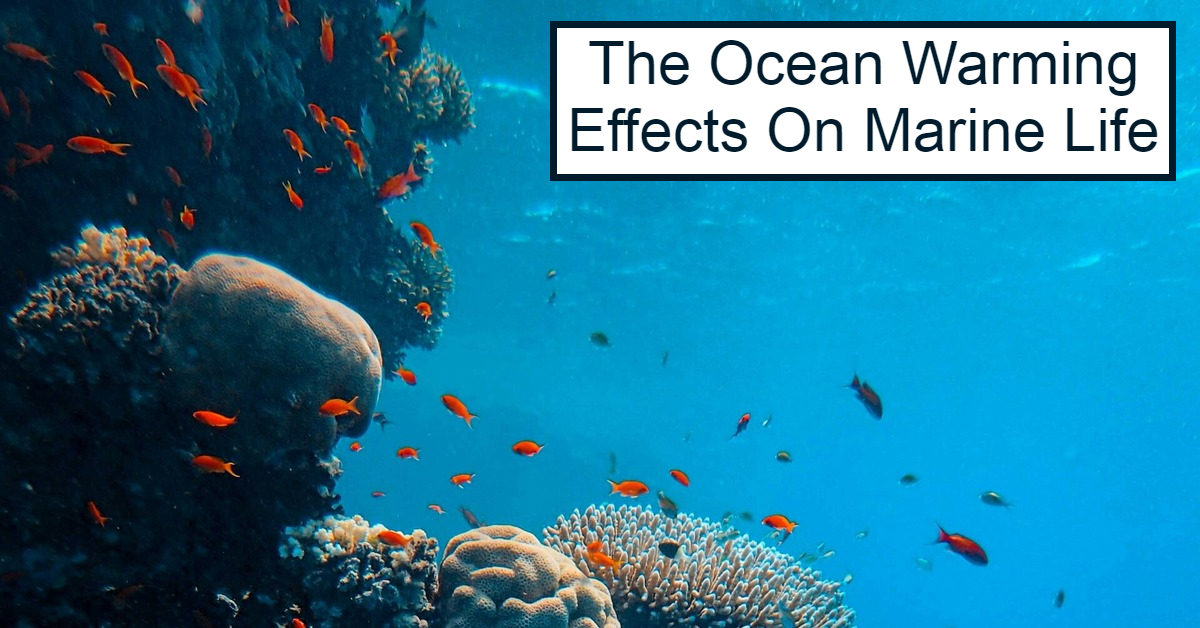
The Ocean Warming Effects on Marine Life
The last few decades have seen ocean temperatures rise as climate change begins to affect maritime industries worldwide. Here are the ocean warming effects on marine life seen so far.
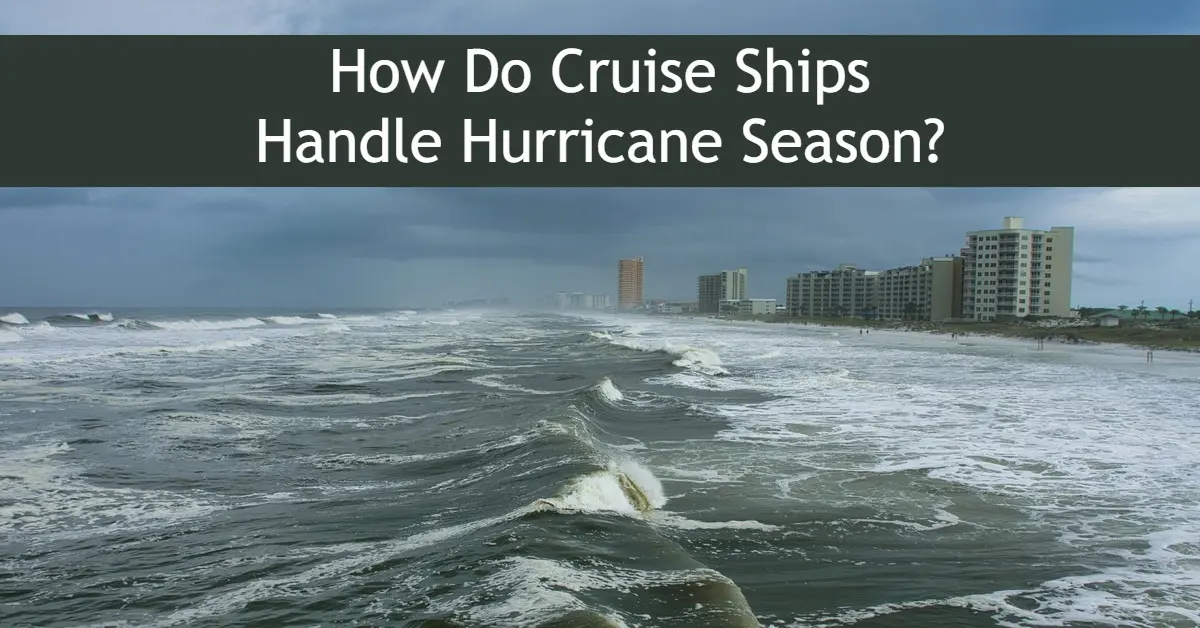
How Do Cruise Ships Handle Hurricane Season Cruises?
Thankfully, modern cruise ships can handle a hurricane season cruise. Due to past experiences and new advancements, crews prove these boats operate well no matter the weather.
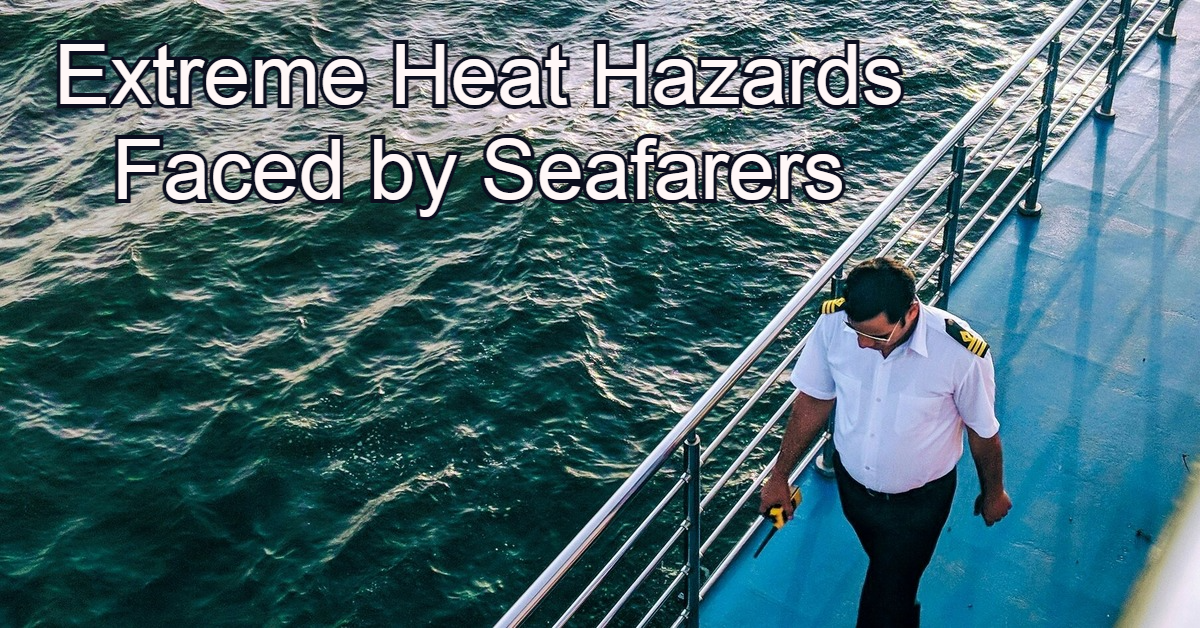
Extreme Heat Hazards Faced by Seafarers
What must sailors know to stay safe and make it back to shore healthy and happy? Here’s a closer look at the extreme heat hazards seafarers face and the precautions and procedures they must know before setting sail.

Discover the Speed of Sailboats: How Fast Does a Sail Boat Go?
Alex Morgan
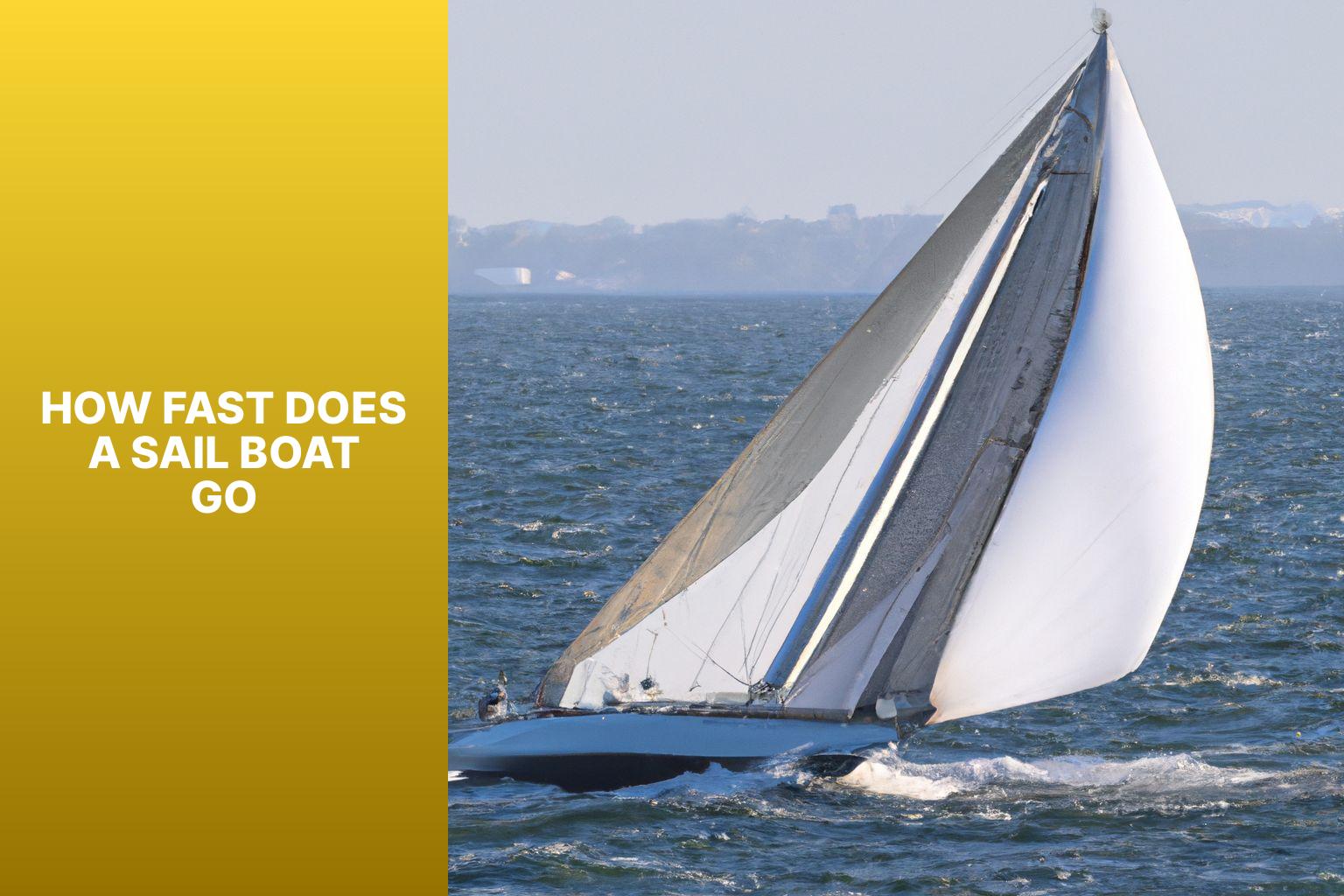
Sail boats have long captivated people with their elegance and ability to harness the power of the wind. If you’ve ever wondered how fast a sail boat can go, this article will provide you with a comprehensive understanding. We will begin with an introduction to sail boats and how they work.
Sail boats are vessels that utilize the wind to propel themselves through the water. They consist of a hull, which is the body of the boat, and one or more sails, which capture the wind’s energy. When the wind fills the sails, it creates a force that propels the boat forward. The angle and shape of the sails can be adjusted to optimize the boat’s performance.
Several factors play a crucial role in determining the speed of a sail boat. The first and most obvious factor is the speed and direction of the wind. The stronger the wind, the faster the boat can potentially go. The sail area and design also affect speed, as larger, more aerodynamic sails generate more power. The design and weight of the boat’s hull impact its performance. Proper trim and sail control, along with favorable water conditions, can further enhance a sail boat’s speed.
To better understand sail boat speed, it is important to grasp the concept of knots. A knot is a unit of speed equivalent to one nautical mile per hour. The average speed of a sail boat can vary based on various factors, but it typically ranges from 4 to 8 knots.
Different types of sail boats have different typical speeds. Dinghy sail boats, which are small and agile, can reach speeds of 5 to 15 knots. Cruising sail boats, designed for leisurely journeys, have an average speed of 5 to 8 knots. On the other hand, racing sail boats, built for speed and competitiveness, can achieve impressive speeds of 12 to 20 knots or more.
If you are looking to increase the speed of your sail boat, there are several factors to consider. Sail trim, which involves adjusting the angle and tension of the sails, is crucial for optimizing performance. Proper weight distribution is also important to maintain balance and reduce drag. Mastering tacking and gybing techniques, which involve changing the boat’s direction relative to the wind, can help maximize speed. Upgrading sails to newer and more advanced designs can significantly enhance a sail boat’s speed.
By understanding the intricacies of sail boat speed and implementing strategies to optimize performance, you can fully appreciate the exhilarating experience of sailing. In the following sections, we will delve deeper into the topic, addressing frequently asked questions and providing valuable insights into the world of sail boat speed.
Key takeaway:
- A sailboat’s speed is influenced by various factors: Wind speed and direction, sail area and design, hull design and weight, trim and sail control, and water conditions all affect how fast a sailboat can go.
- The average speed of a sailboat is measured in knots, with 1 knot equaling 1 nautical mile per hour.
- The speed of different types of sailboats can vary: Dinghy sailboats, cruising sailboats, and racing sailboats all have different typical speeds based on their design and intended use.
What is a Sail Boat?
A sail boat is a watercraft propelled by sails, harnessing wind power. It consists of a hull , which is the body of the boat, and one or more masts with attached sails. The fabric sails are designed to catch the wind and convert its energy into forward motion.
Sail boats work based on the principle of aerodynamics. The shape and angle of the sails create lift when the wind blows against them, similar to an airplane wing. This lift, combined with the boat’s hull design, allows the sail boat to move forward through the water.
The speed of a sail boat can vary and depends on several factors. These factors include wind speed and direction, sail area and design, hull design and weight, trim and sail control, and water conditions. They can affect the efficiency and performance of the sail boat, determining its speed.
How Do Sail Boats Work?
Sail boats work by utilizing the power of the wind to propel themselves through the water. They achieve this through a combination of adjusting the position of the sails and utilizing lift and drag forces. Understanding how sail boats work is essential for safe and enjoyable sailing.
One of the key principles of sail boat operation is the use of sails. Sail boats have sails that capture the wind, similar to how an airplane wing works. The wind creates lift, which pushes the sail boat forward.
Another important component of sail boat operation is the rudder . Located at the stern of the boat, the rudder is a vertical fin that steers the boat by directing the flow of water. By adjusting the angle of the rudder, the sailor can control the boat’s direction.
The keel is another crucial aspect of sail boat operation. It extends beneath the boat into the water and provides stability. It also generates lift, which counteracts the force of the wind and prevents the boat from tipping over.
To change direction, sail boats perform maneuvers called tacking and gybing . Tacking involves turning the bow of the boat through the wind, while gybing involves turning the stern of the boat through the wind. These maneuvers allow the boat to navigate different angles relative to the wind direction.
To optimize the performance of a sail boat, it is important to learn how to trim the sails and make adjustments based on wind conditions. Practice and experience will enhance sailing skills and proficiency.
Factors Affecting the Speed of a Sail Boat
When it comes to the speed of a sailboat, numerous factors come into play. From wind speed and direction to sail area and design, hull design and weight, trim and sail control, as well as water conditions, each element can greatly impact how fast a sailboat can go. Let’s dive into these crucial factors that sailors should consider to harness the full potential of their sailboat and achieve optimal speed on the water.
Wind Speed and Direction
Wind speed and direction greatly impact a sailboat’s speed. A knowledgeable sailor can use the wind to their advantage and adjust their sailing techniques accordingly.
To understand the impact of wind speed and direction on a sailboat’s speed, refer to the following table:
When the wind blows directly from behind, it is called a “ downwind ” condition. Sailboats can achieve their maximum potential speed during this condition by adjusting their sails appropriately.
In contrast, when the wind comes directly from the front, known as a “ headwind ,” sailboats experience resistance and slower speeds. Sailors often need to tack or zigzag to make progress against the wind.
A true story that illustrates the importance of wind speed and direction involves a solo sailor named Paul Larsen . In 2012, he set the world sailing speed record on Vestas Sailrocket 2 , reaching a remarkable speed of 68 knots (78 miles per hour) in Namibia . Larsen’s achievement demonstrates how harnessing the power of the wind can propel a sailboat to incredible speeds.
Remember, mastering wind speed and direction is essential for any sailor looking to maximize their sailboat’s performance and have a safe and enjoyable voyage.
Sail Area and Design
The sail area and design of a sailboat are crucial for performance and speed. Sail area, which refers to the size and shape of the sails and is measured in square feet or square meters, is a key factor in determining the power and speed of a sailboat. A larger sail area allows the boat to catch more wind, resulting in increased power and speed. It is important to balance the sail area with the boat’s hull design and weight to ensure stability and control.
The design of the sails also plays a significant role in the performance of a sailboat. Factors such as shape, curvature, and material can greatly impact its efficiency. Modern sail designs utilize advanced fabrics and shaping techniques to harness the wind more effectively, generating increased lift and facilitating faster sailing.
Optimizing the efficiency and performance of the sails requires proper positioning and trim. Sail trim involves adjusting the angle and tension of the sails to capture the maximum amount of wind and translate it into forward motion.
When selecting a sailboat, it is important to consider the sail area and design that align with your sailing goals. For racing purposes, a sailboat with a larger sail area and a design focused on speed would be ideal. On the other hand, for cruising or recreational sailing, a sailboat with a balanced design that prioritizes stability and comfort may be more suitable.
Hull Design and Weight
Sailboat hull design and weight are crucial for speed and performance on the water. The shape and weight distribution directly affect how the boat moves. Here are key factors for hull design and weight:
1. Hull Design: A sleek and narrow hull minimizes resistance and maximizes speed. It allows the boat to cut through the water smoothly and reduces drag.
2. Weight Distribution: Proper balance and stability result from even weight distribution from bow to stern and side to side. This ensures the boat remains level and responsive to the wind.
3. Materials Used: The choice of materials affects speed. Lighter materials like fiberglass or carbon fiber reduce weight and increase speed. The hull’s strength and durability should not be compromised.
4. Ballast and Weight: Sailboats may have ballast at the bottom of the keel to stabilize and prevent capsizing. The size and placement of the ballast affect both stability and speed.
5. Hydrodynamics: The hull design should consider keel shape, hull angle, and water interaction. A well-designed hull minimizes water resistance and maximizes speed.
To achieve optimal performance on the water, consider hull design and weight when choosing a sailboat. The right shape, weight distribution, materials, and ballast greatly impact speed and overall sailing experience. So, evaluate these factors carefully when selecting a sailboat to maximize your enjoyment on the water.
In 2012, Paul Larsen set the world sailing speed record with the sailboat Vestas Sailrocket 2 , reaching a record-breaking speed of 68 knots (78 miles per hour). This achievement highlights the importance of hull design and weight in achieving high speeds on the water. With advancements in technology and a focus on hydrodynamics, sailboats continue to push the limits of speed and performance, making sailing an exhilarating sport.
Trim and Sail Control
Trim and sail control are crucial for optimizing a sailboat’s speed and maneuverability. The appropriate trimming of the sails enables the exploitation of the wind’s power and ensures maximum efficiency . Sail control entails the adjustment of the main sail, jib, and other sails to maintain balance and control. By skillfully manipulating the sails, sailors can achieve optimal lift and minimize drag, ultimately resulting in enhanced speed . Effective trim and sail control techniques depend on various factors such as wind conditions , boat type , and the sailor’s proficiency level .
Seasoned sailors possess the ability to make precise modifications to refine sail shape and improve performance. The utilization of telltales , which are thin ribbons affixed to the sails, aids in discerning wind flow and facilitates the necessary adjustments to trim and control. To optimize their sailboat’s speed and performance, sailors must continuously assess wind conditions and make ongoing alterations to trim and sail control. The mastery of trim and sail control techniques necessitates consistent practice and accumulated experience.
Water Conditions
When sailing, water conditions significantly impact a sailboat’s speed and performance. Important factors to consider include:
Wind strength: Strong winds increase speed, while light winds can slow the boat down.
Wave height and frequency: The size and frequency of waves affect stability and speed. Large waves can be challenging to navigate, causing the boat to slow.
Currents: Water currents can either boost or hinder speed. Favorable currents provide an extra push, while strong opposing currents slow the boat down.
Tide levels: Sailors need to consider tides when planning routes. High or low tides affect water depth and flow, potentially impacting speed and maneuverability.
Water temperature: Although it doesn’t directly affect speed, water temperature can influence wind patterns. Temperature differences between air and water can create varying wind conditions that may affect boat speed.
In a true story, experienced sailors faced challenging water conditions with strong winds and large waves during an ocean race. Despite these difficulties, they skillfully navigated their sailboat by adjusting sail trim and utilizing their knowledge of water currents. This highlighted the importance of understanding and adapting to water conditions for optimal sailboat performance.
Understanding Sail Boat Speed
When it comes to sail boat speed, several factors are important:
- Wind conditions: The speed of a sail boat depends on the strength and direction of the wind. Strong gusts can enable impressive speeds, while light or inconsistent winds will result in slower speeds.
- Sail size and design: The size and design of the sails play a crucial role in determining the sail boat’s speed. A larger sail area provides more power and can propel the boat faster, especially in optimal wind conditions.
- Hull type: The hull design and shape of a sail boat affect its speed and performance. Smooth-hulled sail boats with streamlined shapes are generally faster and more efficient in the water.
- Crew skill and experience: The crew’s ability to trim the sails, navigate, and make tactical decisions greatly impacts the boat’s speed. Skilled sailors can maximize the boat’s performance by effectively harnessing the wind to achieve higher speeds.
Suggestions to enhance sail boat speed:
- Regularly maintain and clean the sails and hull to reduce drag and optimize performance.
- Invest in high-quality sails and equipment specifically designed to enhance speed.
- Stay updated on weather forecasts and choose sailing routes with favorable wind conditions.
- Continually improve sailing techniques and knowledge through training and practice.
Understanding sail boat speed is essential for sail boat enthusiasts and sailors. By considering wind conditions, sail size and design, hull type, and crew skills, it is possible to optimize the speed and performance of a sail boat.
What is Knot?
The knot is a unit of speed used in navigation and aviation. It equals one nautical mile per hour. One nautical mile is about 1.15078 statute miles or 1.852 kilometers. Knots often measure the speed of sailboats, ships, and aircraft. For example, a sailboat traveling at 10 knots has a speed of roughly 11.5 miles per hour or 18.5 kilometers per hour.
Fun Fact: The term “ knot ” comes from measuring speed by throwing a log or buoy overboard and using a rope with knots at regular intervals to measure the distance traveled. The number of knots passing through a sailor’s hand within a specific time period indicates the vessel’s speed.
What is Knot ?
What is the Average Speed of a Sail Boat?
The average speed of a sail boat varies depending on several factors. Sail boat speeds are measured in knots , which is equivalent to one nautical mile per hour. A cruising sail boat typically travels at speeds ranging from 5 to 8 knots . Some cruising sail boats can reach speeds up to 12 knots in ideal conditions. Racing sail boats, designed for speed , can reach even higher speeds, averaging between 8 to 12 knots and sometimes exceeding 20 knots .
Several factors influence the speed of a sail boat. Wind speed and direction , sail area , and design , hull design and weight , and controls used to trim the sails all contribute to the boat’s speed. Water conditions such as currents and tides can also affect a sail boat’s speed.
It should be noted that these speeds are general estimates and can vary depending on the specific sail boat, weather conditions, and the skill of the sailors. Sailors can use tools like sailing distance calculators and GPS tracking devices to accurately measure their speed and distance covered.
Typical Speeds of Different Types of Sail Boats
Curious to know how fast sail boats can go? In this section, we’ll dive into the exciting world of sail boats and explore the typical speeds of different types. From nimble dinghy sail boats to elegant cruising sail boats and adrenaline-pumping racing sail boats , we’ll uncover the exhilarating speeds these vessels can reach. So, buckle up and get ready to ride the waves as we explore the thrilling realm of sail boat speeds.
Dinghy Sail Boats
Dinghy sail boats , also known as dinghies , are popular watercraft used for a variety of purposes such as recreational sailing, racing, and training. These small and lightweight vessels are designed to accommodate one or two people, and their maneuverability and responsiveness make them ideal for navigating in tight spaces. Due to their efficient design and compact size, dinghy sail boats are capable of achieving impressive speeds. In fact, they are frequently employed in Olympic sailing events , which serves as a testament to their versatility and exceptional performance capabilities.

Cruising Sail Boats
Cruising sail boats are specifically designed for leisurely sailing and comfortable living. These sail boats stand apart from racing or dinghy sail boats due to their larger size and abundance of amenities. With cabins, a galley, and sleeping quarters, cruising sail boats are perfect for longer trips and overnight stays. They prioritize comfort and stability, ensuring a smooth and enjoyable sailing experience. The spacious and accommodating hull design features a wider beam to enhance stability. Their heavier weight compared to racing sail boats aids in stability and reduces the impact of waves. Their smaller sail area makes them easier to handle for recreational sailors.
Cruising sail boats are versatile and able to handle various water conditions, including coastal cruising and offshore passages. Their maximum hull speed is determined by their length. Safety is paramount, and it is imperative to equip these sail boats with GPS tracking devices and life-saving equipment. When searching for a cruising sail boat, take into consideration factors such as size, layout, amenities, and the specific needs of your sailing adventures.
Racing Sail Boats
Racing sail boats are specifically designed for competitive sailing events. These boats are carefully crafted to be lightweight and possess a sleek hull design that minimizes drag in the water. What sets them apart from other sail boats is their larger sail area, allowing them to capitalize on more wind and ultimately achieve greater speeds. To fully optimize the performance of racing sail boats, skilled sailors play a critical role by promptly adjusting the sail trim to maximize speed. The distribution of weight is of utmost importance to maintain balance and stability, especially when cruising at high speeds.
In the realm of racing sail boats, tactics and strategy hold significant value as sailors must timely decide when to tack or gybe in order to maintain the most favorable wind angle. Upgrading the sails of a racing sail boat can substantially impact its speed and overall performance. By integrating cutting-edge materials into the sails, such as high-performance materials, it is possible to elevate the boat’s speed and performance significantly. In racing sail boats, it is common to utilize GPS tracking devices to accurately measure speed and distance throughout races.
Factors to Consider for Increasing Sail Boat Speed
When it comes to increasing the speed of a sailboat, there are some crucial factors to consider. We’ll dive into sail trim , weight distribution , tacking and gybing techniques, and upgrading sails . Unleash the power of the wind on the open water and discover how these elements can make all the difference in reaching new speeds. So, hop aboard and let’s explore the secrets to sailing faster than ever before!
Sail trim is crucial for maximizing a sailboat’s speed and performance. It involves adjusting the sails to utilize the wind power effectively. Consider these key points for sail trim:
- Balancing the sails: Properly balancing the sails is essential for optimal performance. This involves adjusting the angle and tension of the sails to ensure even wind filling.
- Main sail trim: The main sail is the largest and most important sail. The trimmer adjusts its position and shape by adjusting the main sheet, halyard tension, and boom vang.
- Jib/genoa trim: The jib or genoa plays a significant role in driving the boat forward. The trimmer adjusts the jib/genoa using the jib sheet to control the sail’s angle and tension.
- Twisting the sails: Properly twisting the sails helps maintain balance and efficiency. The trimmer adjusts the sail’s twist by controlling the tension in the leech (back edge) of the sail.
- Monitoring wind conditions: Constantly monitoring wind speed and direction is crucial for effective sail trim. Adjustments must be made to compensate for changes in wind strength and direction.
During a sailing race, a sailboat crew noticed their competitors consistently outperforming them. They realized their sail trim was not optimized. They experimented with different sail adjustments, focusing on balancing the sails and adjusting the twist. With improved sail trim, they caught up to their competitors and ultimately won the race. This experience highlights the importance of sail trim in achieving maximum speed and performance.
Weight Distribution
Weight distribution is essential for enhancing the velocity of a sailboat. Here are some crucial factors to take into account:
Balance: Maintaining proper weight distribution ensures the boat’s stability and facilitates efficient movement through the water.
Center of gravity: By keeping the weight centered and low, it prevents the sailboat from becoming top-heavy and enhances maneuverability.
Crew position: The positioning of the crew on the boat significantly impacts weight distribution. They should be strategically placed to achieve optimal performance and minimize drag.
Trimming sails: Skillfully adjusting the sails enables them to efficiently catch the wind and affects weight distribution. The crew should trim the sails according to the wind conditions to maximize speed.
Shifting weight: Depending on the situation, the crew may need to shift their weight from one side of the boat to the other in order to maintain balance and effectively utilize wind gusts.
Weight distribution is influenced by various factors, including the boat’s design, size, and intended use. Making adjustments based on these factors has a positive impact on the sailboat’s speed and overall performance.
Did you know? Correct weight distribution not only increases a sailboat’s speed but also enhances its stability and reduces the risk of capsizing.
Tacking and Gybing Techniques
Tacking and gybing are essential sailing skills. Here is a list of steps for performing tacking and gybing :
Release the working sheet.
Initiate the turn by pushing or pulling the tiller or wheel away from the desired direction.
Cross the bow of the boat through the wind.
Switch the working sheet to the opposite side and trim it in.
Initiate the turn by pulling or pushing the tiller or wheel towards the desired direction.
Allow the boom to swing across the boat as the wind direction changes.
These techniques require practice and coordination with the crew. Anticipate and communicate the maneuvers to ensure everyone’s safety. Always be aware of other boats and obstacles when tacking and gybing .
During a regatta , our team was neck and neck with another boat. To overtake them, our skipper executed a perfect gybe, while the crew swiftly switched the sheets and trimmed them in. Our boat accelerated suddenly, leaving our competitors behind. We won the race due to our skillful tacking and gybing techniques and teamwork .
Upgrading Sails
When it comes to upgrading sails, it is important to assess the condition and performance of your current sails. Look out for any signs of wear and tear, such as fraying or stretching, as these issues can affect the efficiency of your sails. It is a good idea to consult with a sailmaker who can evaluate your boat and provide recommendations on suitable upgrades. Factors such as size, type, goals, and budget will be taken into consideration.
When choosing new sails, consider the sail material that best suits your sailing conditions and preferences. Options like Dacron , laminate , or carbon fiber offer different benefits. If you are looking for enhanced speed and responsiveness, high-tech sails like laminate or carbon fiber could be a great choice. Upgrading to sails with better aerodynamic design and shape, such as flat-cut or radial-cut sails, can significantly improve performance and reduce drag.
Another aspect to consider is the size of your current sails. Resizing them appropriately can optimize their performance. Explore the option of adding adjustable sail controls, like cunningham , outhaul , and boom vang . These controls allow for easy adjustments while sailing, helping to optimize sail shape and performance.
To ensure the longevity of your sails, it is crucial to maintain them regularly. This includes proper cleaning, storage, inspections, and repairs when necessary. By taking care of your sails, you can extend their lifespan and continue enjoying a great sailing experience. Upgrading your sails can have a significant impact on the speed and overall performance of your sailboat.
Some Facts About How Fast Does A Sail Boat Go:
- ✅ The fastest recorded sailboat speed is 68 knots (approximately 78 miles per hour). (Source: Our Team)
- ✅ Monohull sailboats typically travel between six and eight knots. (Source: Our Team)
- ✅ Catamarans and trimarans can reach speeds of nine to ten knots. (Source: Our Team)
- ✅ The average speed of a sailboat depends on factors such as size, hull shape, currents, wind, and body of water. (Source: Our Team)
- ✅ The average cruising speed for sailboats between 30 and 50 feet is around 5.4 to 6.9 knots. (Source: Our Team)
Frequently Asked Questions
1. what is the average speed of a monohull sailboat.
The average speed of a monohull sailboat typically ranges between six and eight knots.
2. Who holds the record for the fastest sailboat speed?
The world record for the fastest recorded sailboat speed is held by Paul Larsen and his Vestas Sailrocket 2, reaching a speed of 68 knots in 2012.
3. What factors affect the speed of a sailboat?
The speed of a sailboat is influenced by various factors such as hull shape, size, wind conditions, currents, and the body of water it is traversing.
4. How can I calculate the speed of my sailboat?
To calculate your sailboat’s speed, multiply the average cruising speed in knots by the time traveled in hours. For example, an average speed of 6 knots would mean covering about 144 nautical miles in a 24-hour period.
5. Where can I find sailboats for sale?
There is a wide selection of sailboats for sale in Florida, which can be viewed online or in a monthly publication available at marinas throughout the state.
6. How does hull length affect sailboat speed?
A longer sailboat can create longer waves and move faster, while a shorter sailboat may experience reduced speeds due to its hull length.
About the author
Leave a Reply Cancel reply
Your email address will not be published. Required fields are marked *
Save my name, email, and website in this browser for the next time I comment.
Latest posts

The history of sailing – from ancient times to modern adventures
History of Sailing Sailing is a time-honored tradition that has evolved over millennia, from its humble beginnings as a means of transportation to a beloved modern-day recreational activity. The history of sailing is a fascinating journey that spans cultures and centuries, rich in innovation and adventure. In this article, we’ll explore the remarkable evolution of…

Sailing Solo: Adventures and Challenges of Single-Handed Sailing
Solo Sailing Sailing has always been a pursuit of freedom, adventure, and self-discovery. While sailing with a crew is a fantastic experience, there’s a unique allure to sailing solo – just you, the wind, and the open sea. Single-handed sailing, as it’s often called, is a journey of self-reliance, resilience, and the ultimate test of…

Sustainable Sailing: Eco-Friendly Practices on the boat
Eco Friendly Sailing Sailing is an exhilarating and timeless way to explore the beauty of the open water, but it’s important to remember that our oceans and environment need our protection. Sustainable sailing, which involves eco-friendly practices and mindful decision-making, allows sailors to enjoy their adventures while minimizing their impact on the environment. In this…

Ridetheducksofseattle is reader-supported. When you buy through our links, we may earn an affiliate commission. Learn more
Average Speed of a Sailboat (How Fast Can a Sailboat Go?)
Written by Anthony Roberts / Fact checked by Jonathan Larson
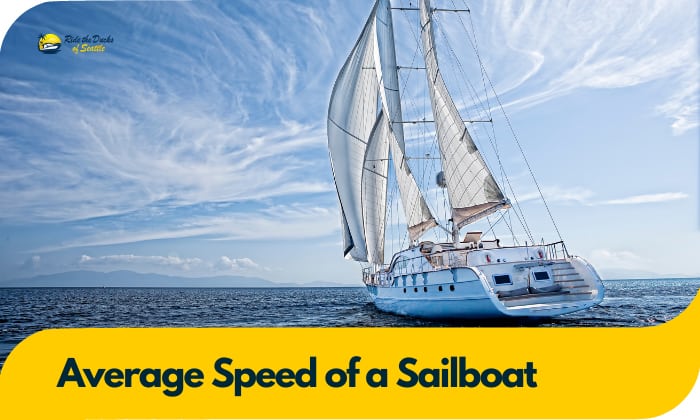
You might have seen how sailing yachts seem to outpace motorized boats in a regatta, prompting you to ask about the average speed of a sailboat. Although the record holder (the Vestas Sailrocket 2) can blitz to 65.5 knots, the run-off-the-mill sailing vessel can only reach four to six knots.
Several factors influence sailboat speeds, and we will examine each in this article. Please keep reading, so you will not miss the invaluable information you will get from this post.
Table of Contents
1. Hull shape
2. sailboat length, 1. alternative measurement, 2. converting knots to kph or mph, 1. hull type, tips to improve speed, frequently asked questions, how fast can a sailing vessel go.
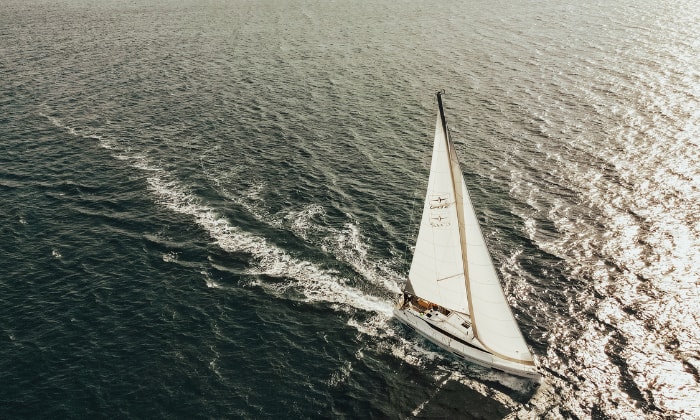
Regatta-competing racing sailboats can reach a top speed of about 20 knots, while custom-built high speed racing yachts can log 50 knots. As mentioned, the Vestas Sailrocket 2 blitzes the waters at a dizzying 65.5 knots (75.38 miles per hour or 121.31 kilometers per hour).
On the other hand, the average sailboat in lakes and other bodies of water can only top the speed charts at seven knots (8.06 MPH or 12.97 KPH), averaging about four to six knots (4.6 to 6.9 MPH or 7.4 to 11.1 KPH).
An 1800s or 1970s sailing ship (i.e., galleon or clipper) has about the same speed as the average modern sailboat. However, it is worth noting that the Sovereign of the Seas logged the highest velocity for a sail-powered ship at 22 knots (25.32 MPH or 40.75 KPH) in 1854.
Meanwhile, the fastest sailing dinghy is the International Moth, blasting the waters at 35.9 knots (41.3 MPH or 66.5 KPH).
So, why the variance?
Two intrinsic (within the boat itself) factors impact the speed of sailboat units. These include hull shape and vessel length.
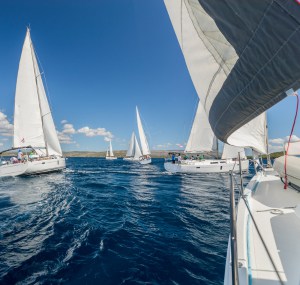
Racing sailboats are faster than cruising yachts because of their unique hull shape differences.
A sailboat built for speed has a super-slim hull and straight buttock lines. The aft section forms a straight line between the slightly wide transom and the hull’s lowest point.
Meanwhile, sluggish sailboats have a “fat tub” hull shape, a narrow stern, and a curvy hull.
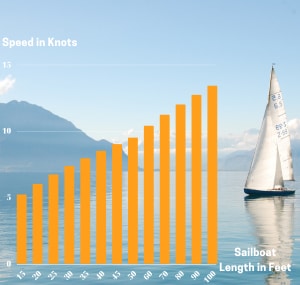
There is a scientific explanation about the impact of sailboat size (or length) on its speed. Sailing vessels create a wave pattern as they move along the water, one at the front and another at the back.
A water wave sufficient to help the boat move occurs if the sailboat’s length is similar to the length of the wave. This phenomenon “lifts” the vessel’s bow, increasing its speed while reducing water resistance.
Hence, a longer sailboat will have a greater cruising speed than short vessels because they can create longer waves.
We prepared the following table to illustrate how vessel length impacts sailboat speed. Hence, a 40 ft. sailboat will always be speedier than shorter sailing vessels (<40 feet).
How to Calculate the Speed
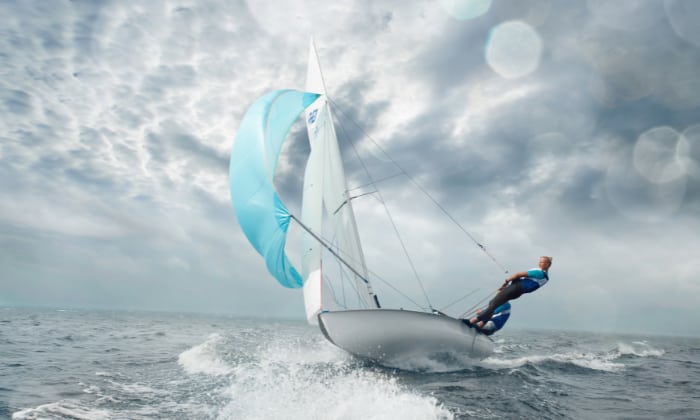
You can use an online sailboat speed calculator, input the required variables, and the system will automatically run the equation. Alternatively, you can determine your sailboat’s average speed by following this simple formula.
Average yacht speed knots = (√(LWL))x 1.34
In which “LWL” is your sailboat’s length at the waterline
Suppose you have a 36-foot sailboat that measures 26 feet at the waterline. The square root of 26 is 5.099. Multiplying this number by 1.34 will result in 6.832 or 6.8 knots.
How about a 59-foot sailing vessel with a waterline length of 47 feet? The square root of 47 is 6.86. We will get 9.19 knots after multiplying 6.86 by 1.34.
Please note that this sailboat speed is the average, provided you have clear skies, calm seas, and an ideal sailboat setup.
For example, suppose we achieved 6.8 knots with 15-knot winds and a sail setup of 50- to 120-degree true wind angle. We can expect our sailboat example to be slower if we do not achieve these conditions.
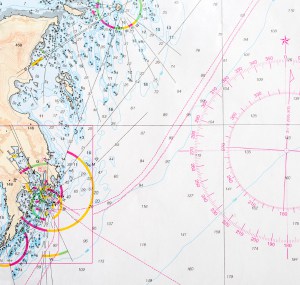
You can also determine your sailboat’s speed by sailing from one point to another. However, you might have to ascertain the distance between these two locations beforehand, and it should be in nautical miles (NM).
Why nautical miles? We are measuring sailboat speeds in knots. One knot is equivalent to one NM per hour. It is worth noting that one NM is 1.15 land-based miles, to put it in perspective.
Take the known distance between the two locations (in nautical miles) and divide the number by the time it took you to complete the journey.
For example, suppose you sailed from Buffalo, New York to Detroit, Michigan, with a distance of 186.99 nautical miles, and it took you 23 hours to complete the journey. In that case, 186.99 divided by 23 hours is 8.13 knots.
You can also take your average sailing distance per day to gain a more comprehensive understanding of your sailboat’s speed. For example, a sailboat with a 6-knot average speed can cover 144 nautical miles in 24 hours (6 x 24 = 144).
Something might be amiss if your boat sailed for 24 hours and covered less than 144 nautical miles. You might have more favorable sailing conditions if you traveled the distance in less than 24 hours.
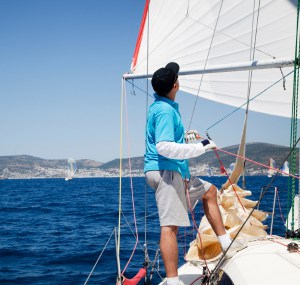
Sailors use “knots” as the unit of measure for vessel speed. Unfortunately, ordinary mortals are unfamiliar with this metric. They are more in tune with “miles per hour” (MPH) or “kilometers per hour” (km/h or KPH).
We mentioned that a nautical mile is slightly longer than a land-measured mile (1.15 statute miles). We also know that 1 NM per hour is 1 knot. Hence, we can multiply the “knot” value by 1.15 to determine your sailboat’s speed in MPH (miles per hour).
A mile is also longer than a kilometer (1 mile = 1.60934 kilometers). Thus, we can assume our KPH values will be higher than knots and MPH. We can multiply “knots” by 1.852 to get the value in KPH.
For example, a top speed sailboat blitzing at 50 knots has a maximum velocity of 57.5 MPH (50 knots x 1.15) or 92.6 KPH (50 knots x 1.852).
On the other hand, a 6.5-knot sailboat can only muster 7.475 MPH or 12.038 KPH.
Factors Affecting Sailboat Speed
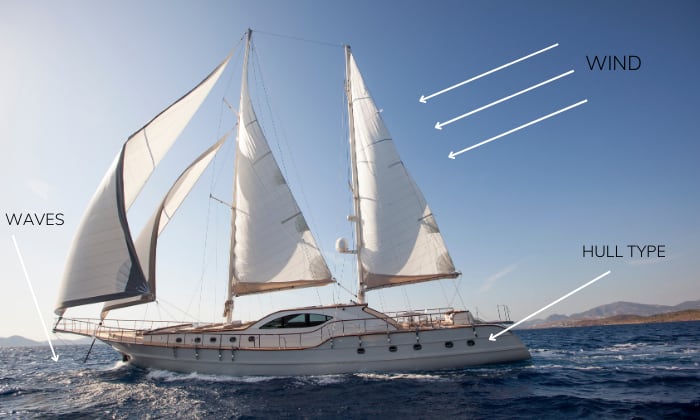
Although we already discussed hull shape and vessel length’s influence on sailboat speed, three other factors can impact watercraft velocity.
Sailboats with at least two hulls (catamarans) are 25 to 30 percent faster than monohulls, given equal lengths.
Hence, if a single-hulled sailboat can go six knots, we can expect a catamaran to have an average speed of 7.5 to 7.8 knots (8.625 to 8.97 MPH or 13.89 to 14.45 KPH). This sailboat hull can match a racing monohull sailboat’s velocity with better comfort.
Add another hull to the catamaran (a trimaran), and you can outpace a racing monohull by doubling its velocity.
Although some sailboats have engines, most rely on wind power for propulsion. Hence, stronger winds can make a sailboat go faster by pushing against the sail. Unfortunately, wind direction can also influence vessel speed. You can go fast if the wind blows in your heading.
You might be inclined to believe that calm waters can make your sailboat go faster. Unfortunately, serene waters often mean gentle winds. And if there is not much wind to push the sail, you cannot expect your vessel to go faster.
Current, wind, and wave or sea condition is the most important factor in determining a safe vessel speed. If the water is rough, it is safer to reduce speed because bad weather can impair visibility and make it challenging to maneuver the vessel.
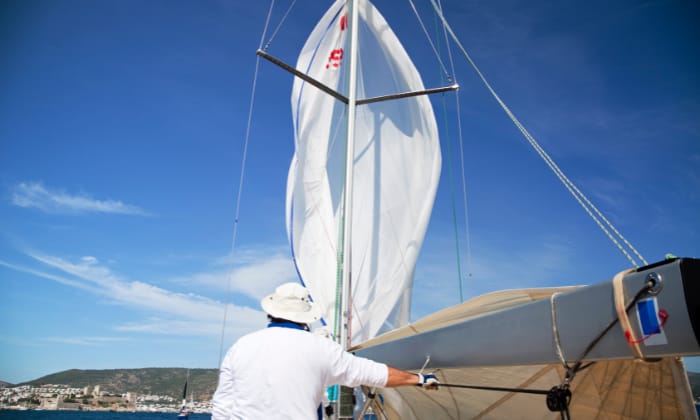
Here are some tips to improve sailboat speed.
- Ensure the sailboat’s proper operating condition, especially the mast, sail, and extrusions. Check the hull and foils.
- Be mindful of the sailboat’s maximum weight capacity, ensuring you do not exceed the rating. Moreover, the correct weight distribution can help you pilot the sailboat faster.
- You might want to brush up on your sailing competencies, including sail control, steering, sail angling, genoa and jib control, kite curling, efficient pumping, and wind positioning.
- Check your sailboat’s settings, including the shroud tension, mast rake, jib car position, mast step position, keel position, and vang tension.

Sailboat speed vs wind speed: which’s faster?
A vessel sailing faster than the wind is possible with a superiorly designed and streamlined hull and the correct sail angle. Otherwise, the sailboat will only be as fast as the wind speed on the sail.
It is also worth mentioning that sailboats with multiple hulls or a planing hull can be faster than wind speeds.
How fast can a sailboat go under power?
A sailboat under power can move on the water at an average velocity of four to five knots (nautical miles per hour) or 5 MPH (8 KPH). This is not very fast but not slow either.
Are catamarans or monohulls faster?
Multihulls (i.e., catamarans and trimarans) are faster than monohulls, averaging about nine to ten knots (10.35 to 11.5 MPH or 16.69 to 18.52 KPH). On the other hand, monohulls only average six to eight knots (6.9 to 9.2 MPH or 11.11 to 14.82 KPH).
The average speed of a sailboat varies across sailing vessel types, sailboat lengths, hull shapes, and hull types. Wind and waves can also influence sailboat velocity.
Given ideal weather conditions, the average sailing vessel can cruise at four to six knots. Custom-built, high-performance racing yachts can blitz the waters at up to 65 knots. Twin-hulled sailboats are 25 to 30 percent faster than their single-hull counterparts, while triple-hulls are super-quick.
Of course, everything depends on wave and wind conditions.\
Read more : The fastest speed of a boat.

Ten years of enjoying countless trips on boats never made me love them any less! So I am here to put all those experiences into good use for other boaters who want to have a safe and fun trip with their friends and families.
Better Sailing
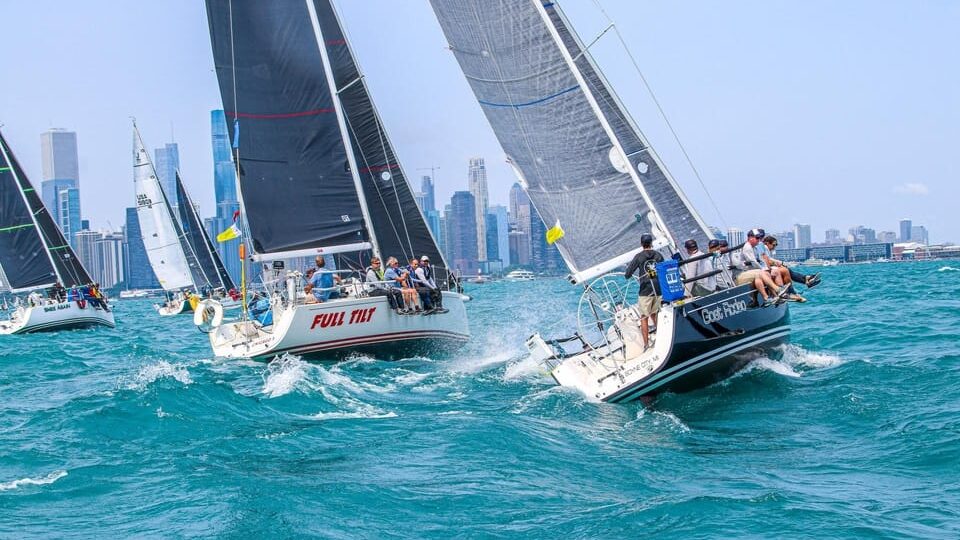
Top Tips For Sailboat Racing
Most Cruising Sailboats are designed for comfortable sailing and living aboard. When informal racing becomes available, I find that some people pass on the opportunity because they feel their boat might not be suitable for competition. By using the following 13 ideas, sailors who occasionally enjoy racing can improve their performance and have more fun on the water.
Preparation before the race is time well spent. Read the sailing instructions carefully to understand the schedule, racecourse, and rules of the regatta. Next, recruit the correct number of crew for your boat. Sailing with too many or too few people makes it harder to perform efficiently. Next, study the weather so your team will have the correct clothing, set the most appropriate sails, and feel comfortable with the conditions you will sail in. Keep the boat light. Take off any items that you will not need for the race. Too much gear will slow the boat down. This may take a little time, but the boat will sail faster, and the extra room will make it easier for the crew to handle the sails and move around.
Before the race, hold a crew meeting. During this session, assign each member of the crew a specific job to do during key moments of the race, such as the start, rounding marks, changing sails, or maneuvering. This is the time to discuss the weather forecast, explain the racecourse, and set your goal for the day. Head out to the course at least one hour before the race. From the moment you leave the harbor, take the attitude that you are racing.
Sailboat Racing Start Tactics
Practice at least two starts. I like to try one practice start at each end of the line. Make a note of which end of the line seems to be favored (closer to the first mark of the course). Next, study the course to determine which side might have more wind. The best way to do this is to look at other boats. Ask yourself which boats appear to be heeling more or sailing faster. Every member of the crew should work in his or her pre-assigned area during practice. When you make the final approach to the starting line, avoid getting locked up with another boat.
Your goal is to start with full speed and clear wind. This is easier if you can start cleanly. Accelerate up to full speed at least 10 seconds before the gun. Most cruising boats are relatively heavy and take time to reach full speed. Ask one crew member to take bearings as you approach the line. You should be within one-half a boat length of the line at the start.
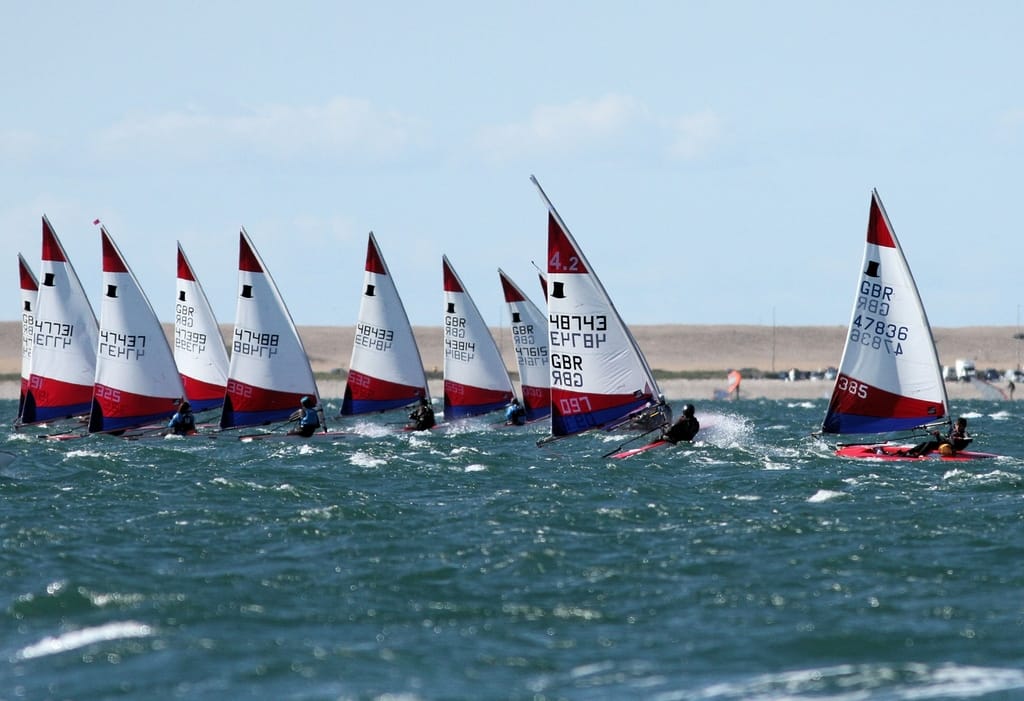
On the first leg, stay on the same course for two minutes or longer before making the first maneuver. When you prepare to tack, make sure the entire crew is ready. Watch carefully to make sure you will be sailing in the clear wind (clear of other boats) after the turn. If you think your boat is gaining by sailing straight ahead, keep going. If your side of the course seems to be losing distance to other boats, then you should consider switching sides of the course. Only tack when you have a reason; a big mistake many tacticians make is tacking too often.
Constantly study the wind. When reading the wind, wear polarized sunglasses to help cut the glare and make seeing the wind ripples easier. Use all available indicators to see what the wind is doing. This includes the course other boats are steering or how far they are heeling over, fags onshore, smoke from stacks, and the angle of anchored boats.
Maneuvering:
All boats lose considerable distance while tacking or jibing. Prepare your crew well in advance of any turn. But be careful not to shout too loudly; you don’t want the competition to know when you are about to tack. Sail at full speed before making your turn. Never turn the boat faster than the crew can trim the sails onto the new side. A tack should be broken up into three stages: the first third of a tack or jibe should be slow. The harder you turn the rudder, the more the boat will slow down.
The second part of the turn should be faster. This is when the wind is straight ahead during a tack and straight behind during a jibe. The last part of the turn should be slower while the sails full and your boat accelerates. Look at the course you have steered by studying the water behind your boat. If the shape of the turbulence in the water resembles the shape of a question mark, it is an indication that you have turned the boat too quickly.
Skippers gain popularity with crews by allowing several people to steer during a race. While at the helm, concentrate on just steering. Use every source of information available. This list includes the speed and wind instruments, the angle of the heel of the boat, and the telltales flowing from the sails. If a big gust of wind is approaching, prepare to sail a higher course to keep the boat from heeling too much. Tell your mainsail trimmer to prepare to drop the traveler to leeward or ease the sheet out. Overheeling makes a boat go sidewise and lose speed.
The most skilled helmsmen work to keep their boats sailing fast by avoiding sailing a course that is too close to the wind and, therefore, slow. The best way to determine if you’re sailing efficiently is by studying your boat’s speed compared to the competition’s. This is the job of the tactician. Use a hand bearing compass to tell if you are gaining or losing bearing to another boat.
Trim your sails to perfection. The maximum draft of all sails should be about 40 percent of the way aft of the leading edge. Sight up the mainsail’s boom — the top batten should be parallel to the boom. Try to set the leech of the jib to be in line with the curvature of the mainsail. If the jib is lufng at the top before the bottom, move the jib lead forward. If the jib is lufng at the bottom of the sail first, move the jib lead aft. Your goal is to have the telltales all lufng at the same time. If you fly a spinnaker, set the pole so that it’s perpendicular to the mast. Raise or lower the spinnaker pole, so the bottom corners (the clews) of the sail are in line with the horizon.
If the boat is heeling too much, fatten the shape of the main and jib. Anytime you take tension in a sail, the draft will move in that direction. If your boat is sailing in light wind and you’re sailing slowly, ease the sheet, downhaul, and halyard to give the sail a more curved shape. One crew should constantly trim the mainsail while another crew trims the jib or spinnaker. The helmsman and the trimmers should talk to each other. If the helmsman is heeling too much, he should ask to reduce the power in the sails by easing them out or fattening out the draft in the sail.
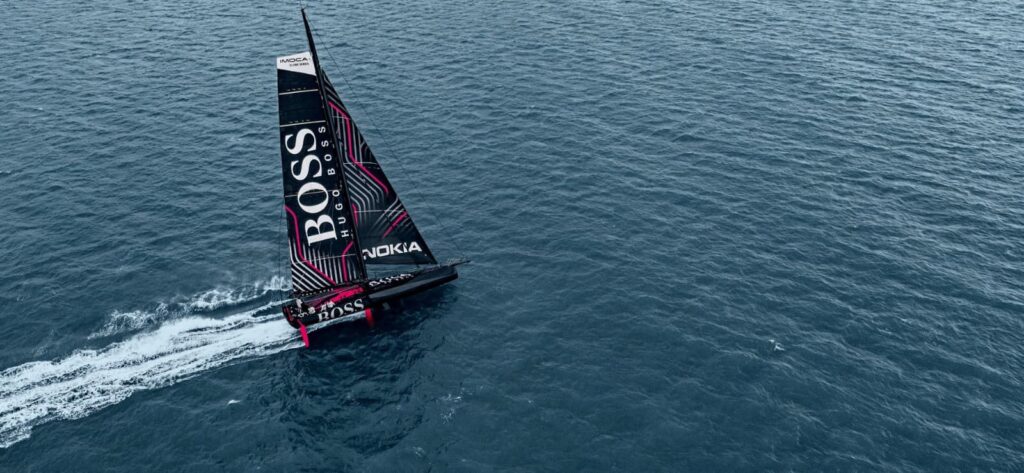
Know the Basic Racing Rules
The rules are complex and require years of practice or study to understand all the subtle nuances. But the fundamental rules are designed to keep boats from having collisions. If you’re on a starboard tack, your boat has the right-of-way. If you’re too leeward, your boat has the right-of-way. An overtaking boat must stay clear of a boat ahead. An inside boat approaching a turning mark is entitled to room to pass the mark. If you must alter course to stay Hands-On sailOr clear of a right-of-way boat, it helps to hail the other boat that you are changing course. The rules are based on common sense.
Sail in Clear Wind
The wind shadow of boats can extend as far as 10 boat lengths. Avoid sailing in the exhaust of another boat. Note the position of your masthead. If it points at another boat —whether on a windward leg or a leeward leg — the other boat is likely giving you disturbed wind. Your options are to tack or jibe away or sail a different course until your wind is clear.
Communications:
On every vessel there is one person in charge. All information must be funneled to the skipper. This is the person who will make the final decisions. Input from the crew is always helpful. The tactician should note a boat’s progress, making the calls relative to your boat; for example, “We are sailing 5 degrees higher.” I have been on boats where a skipper will yell more and more about less and less. Screaming is no fun. A calm, steady voice will give the crew confidence that the correct calls are being made. When you are giving commands, speak in the direction of the crew so they can hear you, use as few words as possible, and explain things in precise terms. For example, ask to ease the jib 4 inches or head up 5 degrees. avoid making vague, confusing comments such as “ease the jib a touch.”
Keeping a crew happy is important. Everyone is on board to have a good time. As mentioned, yelling must be avoided at all costs. The tactician can build morale by forecasting what will happen in advance. An example might be, “We are going to tack in eight boat lengths. after the tack, we are going to sail five degrees low, of course, to gain speed for a bad set of waves that are approaching from a powerboat.” issuing team shirts or hats build team spirit. A well-fed crew is always happy. Be sure everyone is wearing the correct clothing, uses sunscreen, and most importantly, wears good shoes or boots. I have seen many injuries happen to barefoot sailors. When something goes well, be sure to compliment everyone.
Racing Philosophy:
Level of sailing, work to keep a good average score throughout a multiple-race regatta. Avoid taking big chances or splitting away from the fleet. One of the biggest mistakes is to get into a battle with just one other boat while allowing the rest of the fleet to sail away. When the wind is light, the skipper and crew need to be patient. Every member of the crew should be encouraged to add suggestions. The key is when to give advice. as a skipper, I like to ask questions about where the best wind seems to be or what actions other boats are taking. Don’t get too excited when you are in the lead and don’t get too upset when things go wrong. When behind, I tell my crew, “Just for fun, let’s see how much ground we can make up.”
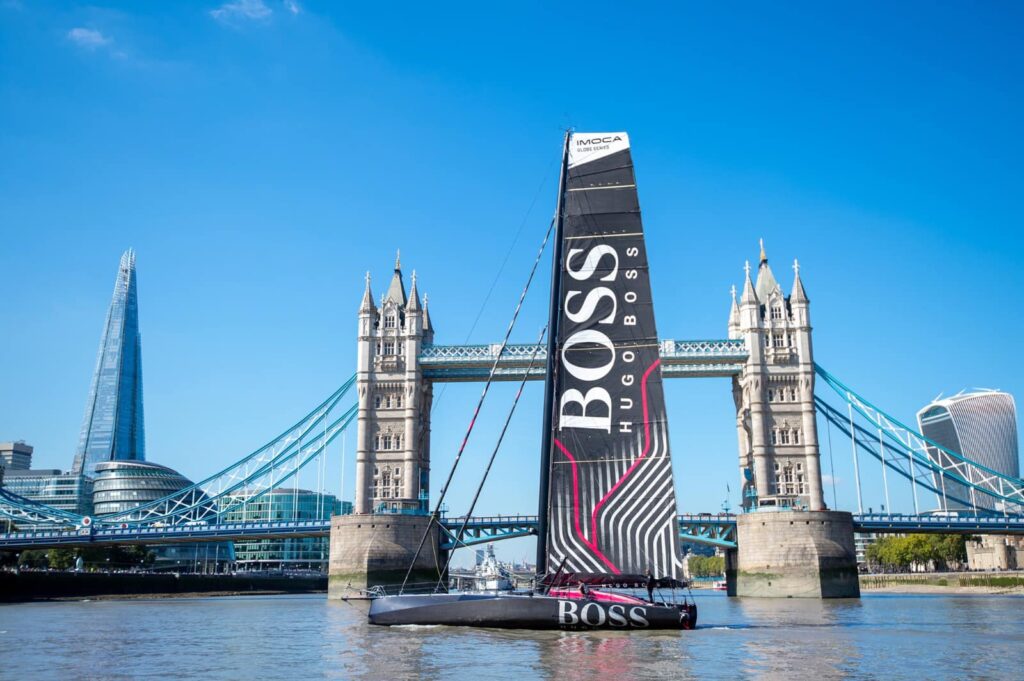
Little Things Can Make a Big Difference
Many small adjustments add up. Keep your crew in the middle of the boat fore and aft. in light wind, move the crew to leeward. When the wind comes up and the boat heels over, move the crew to the windward side. During a race, I ask the crew to move frequently as the wind velocity changes. Watch the other boats. If you observe something going well on a competitor’s boat, use the idea.
After the Race
Afterward, take the time to have another crew meeting to discuss what went well and what can be done better for the next race. Make a list. If any equipment is broken or didn’t work well, get it fixed before the next race. Clean the boat up, fold sails, put the covers on, and put everything in its proper place before breaking out the snacks and drinks. Every member of the crew should participate. If your boat didn’t win, be sure to congratulate the winner. They will return the favor when things go your way. Always attend some part of the post-race festivities. The hosts appreciate your attendance. Finally, be sure to schedule your next race and invite the crew for another good time on the water.
Peter is the editor of Better Sailing. He has sailed for countless hours and has maintained his own boats and sailboats for years. After years of trial and error, he decided to start this website to share the knowledge.
Related Posts

Atlantic vs Pacific: Which is More Dangerous for Sailing?

Why Do Sailboats Lean?

How Does a Boat Sail Upwind? Unveiling the Mechanics of Against the Wind Sailing

How Does Sailing Work? The Physics of Sailing
- Buyer's Guide
- Destinations
- Maintenance
- Sailing Info
Hit enter to search or ESC to close.

Best Vehicles In Lego 2K Drive
- Lego 2K Drive is a charming racing game with unique gameplay and vehicles that can transform mid-race.
- The McLaren F1 LM is incredibly fast but has poor acceleration, while the Chamfered Wagon is well-balanced and great for tricky corners.
- The Cat Deville and Supersonic Jet Boat are reliable and fast vehicles, while the Foul Runnings Boat excels at catching up and maintaining a steady pace.
Lego 2K Drive is a fast-paced, fun, and incredibly charming Lego racing game that is unique in the way it plays. One of the major standout features of the game is the vehicles themselves, which can transform in the middle of a race to navigate around the course. The game also features vast open areas that can be fully explored by the player, with each of them containing a few challenges and competitive races that will need to be completed to move the plot forward.
LEGO 2K Drive: All Trophies and Achievements
The truth is, while speed is very important in Lego 2K Drive , the sheer variety of tricky challenges mean that a vehicle needs to still be balanced overall to be considered reliable, and luckily, there are plenty of exciting cars, and boats too, that fit this description. These are the very best vehicles in the game that players need to get their hands on as soon as possible.
McLaren F1 LM
- Acceleration: -9
- Handling: +6
This glossy orange McLaren is incredibly fast once it gets going, and while it can complete speed challenges like nobody's business, it also relies on the player's driving skills for it to be fully effective because of how dreadful the acceleration is. With that being said, so long as the driver manages to avoid any bumps or nasty turns, they'll have a real speed demon on their hands. It also possesses some fantastic handling that can help with some of the sharper tracks.
Aside from its stats, the McLaren F1 LM also has a very sleek design, which is a real feast for the eyes, and as long as players aren't too reckless with this car, it will serve them very well in the long run.
Chamfered Wagon
Speed: no difference.
- Acceleration: -3
The Chamfered Wagon might not boast the immense speed of some of its peers, but it's still a fantastic vehicle overall that can easily keep up with fellow racers while also handling tricky corners with ease. The majority of the street cars in this game are double-edged swords that place a lot of emphasis on one stat over the other, but the Chamfered Wagon is the only one that is fairly balanced overall.
Fortnite Rocket Racing: How to Drift
It also possesses some of the best handling in its vehicle class, making it usable for pretty much any type of challenge and stage, and the fact that it's also a heavy car makes it a real force to be reckoned with on the track.
Cat Deville
- Acceleration: -8
- Handling: No Difference
From appearances alone, the Cat Deville can seem like somewhat of a gimmick car with its bright pink cat ears and tongue poking out at the front, but it's an extremely reliable vehicle that is more than capable of holding its own in a race. Similar to a lot of street cars, the Cat Deville does admittedly possess a lackluster acceleration stat, but it more than makes up for this with its speed and handling, which ensure that it never feels too clunky to use.
What makes this car shine is that, despite being fairly easy to control, it's still classed as a "Heavy" vehicle, meaning that it will have no problem knocking other racers, or enemies in general, out of the way.
4x4 Adventurer
- Acceleration: -6
- Handling: +12
- Health: +18
The 4x4 Adventurer is the closest equivalent to a monster truck in the entire game, being a big and sturdy off-roader that has a ton of health and surprisingly good handling. The slow speed can be a letdown, but it doesn't matter too much, since a lot of the off-road sections are more about dodging environmental obstacles rather than traveling as fast as possible.
The gigantic design of the car also makes it virtually unstoppable in regular races, since it can easily bash its competition out of the way and will take little to no damage itself. It's an incredibly fun car to use, and one that can prove to be extremely useful for a lot of the obstacle courses.
Organ Donor Truck
- Acceleration: +3
- Handling: -6
- Health: -12
It's hard to find a vehicle in this game, and any racing game for that matter, which has a more creative and memorable design than the Organ Donor Truck. While it has an incredibly unique look, this off-roader is still no slouch when it comes to its stats, boasting a very quick speed and acceleration, which is very rare for these types of cars.
It's very reliable and can cruise through jungles and dirt roads with ease, but on the other hand, it's incredibly fragile and can break down after just a few hits. It might not be very sturdy, but the Organ Donor Truck still excels in the speed department, and its handling is still good enough to ensure it doesn't feel like it's constantly driving on ice.
Dusty Roadster
- Handling: +4
The Dusty Roadster is without a doubt the jack-of-all-trades in terms of off-road vehicles. The acceleration may not be up to everyone's standards, but it doesn't matter when the car handles as well as it does while still having a blistering max speed . It's an incredible vehicle for the Rescue minigame since it makes picking up civilians so much easier, even if the car is a little light on its feet.
Additionally, it's one of the best cars in the game for the regular Cup Series Mode, since it can excel on virtually any kind of track. It also helps that the blue, white, and yellow design scheme is so eye-catching, to the point where it can be a little difficult to focus on the race at hand with such a wonderful-looking car on-screen.
The Evaporator isn't a heavy-duty kind of boat. In fact, it doesn't stand a chance in the face of any obstacles, but with that being said, it can still make quick work of maps that have long-running stretches of water for it to glide across. It also manages to maintain a good speed without sacrificing any of the acceleration, so even if it does spin out in the middle of the race, it will be able to catch up in no time at all.
The 10 Best PS5 Racing Games, Ranked (December 2023)
It can be extremely difficult to get accustomed to the Evaporator's limited health, but if players remain fully aware of what can and cannot harm them during a minigame or race, then it's a fantastic boat to take out for a spin.
Foul Runnings Boat
No one can stop the Foul Runnings Boat once it reaches full speed, and while it's not always a guarantee that this will happen, it's much better suited to skilled players who can avoid any harm during a race to maintain a slow but steady pace to reach the top. Luckily, many courses provide plenty of space for the boats to drive around in, and it's these areas where this specific boat can stretch its legs to outrun the competition.
It's not going to be doing any heavy lifting since it is still a little low on health, but the Foul Runnings Boat is amazing for catching up in a race, or simply leaving everyone behind by gaining a long and healthy lead.
Supersonic Jet Boat
Considering that this peculiar vehicle is a jet and a boat fused into one, it makes sense that it would have an advantage over its competition, but it's truly astonishing just how fast and efficient the Supersonic Jet Boat is. The only area where it falters is the acceleration, and while this might seem a little troubling, it's also the only vehicle of its class to have no more than a single minus stat, making it incredibly reliable and efficient.
There isn't a single mode where this jet boat isn't useful, and while it isn't ideal for beginners who might still have a little trouble avoiding any damage during a race, it's nonetheless the best boat in the game by quite a margin.
LEGO 2K Drive
Platform(s) Xbox Series S, Xbox Series X, PS5, PS4, PC, Xbox One
Released 2023-05-19
Developer(s) Visual Concepts
Genre(s) Racing


Average Speed of a Sailboat (Plus Top Speed)

Last Updated by
Daniel Wade
June 15, 2022
Going fast in a sailboat can be lots of fun. But what is the average of a sailboat? Well, let's find out.
The delight and gratification that comes from speed can be a big plus for adrenaline-seeking sailors. Well, nothing can fire up the adrenaline more than having a speedy boat ride out on the water. This is essentially why having an idea of how fast a sailboat can go is of great importance. When it comes to looking at the speed of a sailboat, it can be crucial to consider the types of activities that you'll be using your sailboat for. In fact, your sailboat should only be considered ideal if it meets the level of expectations required of it in terms of speed and activities on the water. Even with this, the speeds of sailboats can vary based on several factors. But what is the average speed of a sailboat?
The top speed of a sailboat will vary based on its size and purpose. For example, high-end racing sailboats are purposely designed to reach maximum speeds while larger and bulkier sailboats may be slower due to drag and friction. That being said, the average speed of racing sailboats is 15 knots (17 mph). On the other hand, the average speed of cruising sailboats is 4-6 knots (4.5-7 mph) and can attain a top speed of 7 knots (8 mph). In essence, cruise speeds of over 8 knots are quite normal.
Let's get into the details.
Table of contents
Measuring Sailboat Speed
The nautical measurement of speed is the knot. According to the World Sailing Speed Council, one knot is equal to about 1.15 mph. The knot measurement is dependent on the circumference of the Earth. So if your sailboat is cruising at an average speed of 1 nautical mile per hour, it means that it's cruising at a speed of 1 knot.
Modern sailboats have GPS tracking devices that can be used to measure the distance covered, as well as the speed at which the sailboat is sailing.
Factors that Determine the Speed of a Sailboat
Different types of sailboats can attain different speeds. There are several factors that can determine the speed of a sailboat. Let's take a look.
The Length and Size of a Sailboat
While the speed of a sailboat will depend on several factors such as currents, wind conditions, and many other factors as we'll discuss later, the most important thing that can influence the speed of a sailboat is its size and length. You may be asking yourself; what's the connection between the length of a boat and its speed?
Well, the ability of a sailboat to go fast depends on the harmonizing act between its length and the power that drives it. When a sailboat moves through the water, it creates a pattern of waves. These waves include one along the side of the sailboat, which produces a ridge of water at the bow and a trough at the stern.
If the length of the wave is almost equal to the length of the boat, it creates a huge ridge that shoves the sailboat back into its trough, thereby slamming it up against an almost dense wall of water resistance. This then gives the sailboat sufficient speed to lift its bow out of the water and the ability to skim above the bow waves while allowing it to overcome the resistance that the water or the waves create.
A sailboat, of course, needs a lot of power to get over the hump in the resistance curve. So a longer boat will have a higher speed than a shorter boat. This is because a longer sailboat will create longer waves across its hull and move faster. On the other hand, short sailboats tend to generate shorter waves, thereby will have reduced speeds. In essence, it's almost impossible for a sailboat to travel faster than the speed of a wave if the wave is longer than the boat.
In most cases, boat designers create extreme lengths to get boats over the mound of the wave resistance. While a lightweight boat can easily achieve this, it can leave you shorthanded in heavy winds as it can be easily pushed by the winds. Again, it may not have the stability needed to carry enough sails to get the appropriate power to sail on the water. So if the boat is light, it should at least have a double hull to at least compensate for its instability.
The Shape of the Hull
This may be hard to believe but some hulls are more efficient than others when it comes to creating the wave resistance that is needed to move the boat. Generally, hulls should be very slim and carefully shaped. Keep in mind that a sailboat that has a hull that's shaped like a fat tub will not be as fast as a sailboat with a very slim hull even if they're of the same length.
A proper indication that the hull has the ability to be faster depends on its aft or buttock lines. If a hull has a straight line from the lowest point of the hull to the transom and the transom is a little bit wide, the boat will not only be stable but will be much faster. On the contrary, a hull that curves a lot but has a narrow stern may not be that fast. In essence, hulls play an integral role in slicing through the water and do not push water aside and down.
Comparing the Speeds of Catamarans and Monohulls
Are catamaran or trimaran hulls more superior to Monohulls in terms of speed? Well, cruising on a sailboat with a cat hull will be much faster than cruising on a sailboat with a monohull by 25%-30% if the two sailboats are of the same length. A catamaran hull will not only achieve speeds of a racing monohull but will be more comfortable to sail on.
A tri-hull is even much better in the sense that they're generally designed towards the performance end of the spectrum. They will, therefore, double the speed of a racing monohull.
The only downside of a cat and trimaran hull is that they're more sensitive to loading and their performances will significantly suffer if they're loaded. On the other hand, a monohull can perfectly handle loading and this is a huge advantage is you're planning to sail with a crew. To this end, you should consider keeping your cat or tri boat as light as possible if you want to maximize speed. We all know that keeping your sailboat light is as difficult as they come but it's of importance if speed is your main goal.
Monohull (6-8 knots)
Most average sailboats are designed with monohulls. They're generally displacement hulls designed to split through the underwater. This not only stabilizes the boat but slices through the water smoothly. If you want to make a monohull sailboat much faster, you can consider raising the entire hull above the water.
Catamarans and Trimarans (9-10 knots)
Unlike monohulls, cats and trimarans are located on top of the water. This means that they'll be displacing less water, thereby making them a lot faster. The only downside is that this design will make the boat less stable, which can be a cause for concern given that safety should always come first while on the water. This is essentially why catamarans and trimarans have two and three hulls respectively. This will, however, make the boat extremely buoyant.
Waves play a critical role not just in the speed of your boat but also in the safety of your boat. We all know that waves are very unpredictable. They can be calm and gentle but can suddenly become wild, confusing, irregular, and angry.
Generally described as freaks or rogues, waves can be very dangerous. They can bully your boat and attempt to roll it over. Waves can also make your boat faster or slower. As such, waves can either positively or negatively affect the speed of your sailboat. Given that calm waves cannot be appropriate in achieving the maximum speed of your boat, the right wave condition that should enable your sailboat to move faster should overlap and interfere in the right way.
The wind is the only thing that propels sailboats. The wind will fill up the sails, which is then used to move the boat. Both true winds and apparent winds can be integral in moving the boat forward. True wind is essentially the type of wind you feel when you stand still and it's what pushes a boat. Needless to say, strong winds may move a sailboat faster than calm winds but this may depend on the wind direction.
How to Improve the Speed of Your Sailboat
Having looked at the average speed of a sailboat, as well as factors that may affect its speed, it's important to highlight how to improve the speed of your sailboat.
It's important to make sure that your sailboat is properly designed to attain maximum speed. The sailboat should also be properly maintained and serviced to work at maximum speed. Make sure that the hull and foils are clean and in perfect shapes. Here's what to do.
- Make sure that the foils do not have seaweeds or plastic bags
- Ensure that the hull is in tip-top shape and can hold tension
- Make sure that the sails are in the right conditions
- Make sure that the masts have the right stiffness
You may have a lot of difficulties reaching your targeted speed if the weight of the crew exceeds the appropriate capacity of your sailboat. This is because there will be some sort of drag and tension and this may significantly hinder the speed at which the boat travels. In essence, a lighter boat may be a lot faster than a heavier boat. This is what you should do.
- Make sure that the weight is appropriate
- Ensure that the boats overall weight is moving aft and out appropriately
- Make sure that the maximum weight is not exceeded
The settings of your sailboat can either negatively or positively affect its speed. For instance, you should make sure that the mast rakes, mast step position, shroud tensions. Jib car position, vang tension, and keel position, as well as any other part of the sailboat, are perfectly set to make the boat faster.
You should compare various settings and figure out which type of settings gives you maximum speed. Here are some of the things to do.
- Ensure that jib cars are in the right position
- Make sure that your mainsails are in the right position
- The vang tension should be efficient
The technique you use on your sailboat can make a difference when it comes to your speed. Techniques such as steering and trimming can be a huge speed factor, particularly when the conditions at sea are difficult. You should also have varying trimming techniques. Here are some important skills.
- Know how to steer perfectly
- Know how to control primary upwind
- Know the right amount of curl to have in your kite
- Make sure that you're pumping efficiently
- Know how to play the jibs and genoas
These factors can be of great importance in increasing the speed of your sailboat. You can use them efficiently next time you want to be up to speed.
Bottom Line
Sailing speed is, without a doubt, one of the most favorite discussions among sailors. Most sailors often try to figure out how to make their sailboats faster or why a given sailboat is faster than another one. In essence, the average speed of a sailboat ranges between 4 knots to 15 knots but this may depend on the size and type of the sailboat, as well as other factors. This means that the average speed of sailboats is 8 knots but there several factors such as the type of the hull, waves, and wind conditions can affect the speed of your sailboat.
It's, therefore, important to know how these factors may affect your speed and what you need to do about them. For example, your sailboat may not be as fast as you may want if it's not properly prepared or maintained.
Related Articles
I've personally had thousands of questions about sailing and sailboats over the years. As I learn and experience sailing, and the community, I share the answers that work and make sense to me, here on Life of Sailing.
by this author
Learn About Sailboats
How to Sail
Most Recent

What Does "Sailing By The Lee" Mean?
October 3, 2023

The Best Sailing Schools And Programs: Reviews & Ratings
September 26, 2023
Important Legal Info
Lifeofsailing.com is a participant in the Amazon Services LLC Associates Program, an affiliate advertising program designed to provide a means for sites to earn advertising fees by advertising and linking to Amazon. This site also participates in other affiliate programs and is compensated for referring traffic and business to these companies.
Similar Posts

Affordable Sailboats You Can Build at Home
September 13, 2023

Best Small Sailboat Ornaments
September 12, 2023

Discover the Magic of Hydrofoil Sailboats
December 11, 2023
Popular Posts

Best Liveaboard Catamaran Sailboats
December 28, 2023

Can a Novice Sail Around the World?
Elizabeth O'Malley

4 Best Electric Outboard Motors

How Long Did It Take The Vikings To Sail To England?

10 Best Sailboat Brands (And Why)
December 20, 2023

7 Best Places To Liveaboard A Sailboat
Get the best sailing content.
Top Rated Posts
Lifeofsailing.com is a participant in the Amazon Services LLC Associates Program, an affiliate advertising program designed to provide a means for sites to earn advertising fees by advertising and linking to Amazon. This site also participates in other affiliate programs and is compensated for referring traffic and business to these companies. (866) 342-SAIL
© 2024 Life of Sailing Email: [email protected] Address: 11816 Inwood Rd #3024 Dallas, TX 75244 Disclaimer Privacy Policy

COMMENTS
Racing sailboats usually skim over the water at around 15 to 20 knots. For comparison, the average speed of a traditional sailboat is only around 5 to 8 knots. Some custom-designed boats can reach record-breaking speeds of up to 50 or more knots. Since sailboats don't rely on internal power for speed, many factors determine the speed of a ...
An F50 catamaran preparing for the Sail GP series recently even broke this barrier, reaching an incredible speed of 50.22 knots (57.8mph) purely powered by the wind. This was achieved in a wind of ...
Regular sailboats go at an average speed of 4 to 7 knots (4.5 to 8 mph). Racing sailboats go up to 15 to 20 knots (17 to 23 mph). Some boats, like Paul Larsen's Vestas Sailrocket 2, reached a speed of 65.45 knots (75.32 mph or 121.22 km/h). These numbers are just for your reference.
And, by lifting the boat out of the water, drag from the hull is significantly reduced, allowing boats to hit previously-unheard-of speeds. On the F50 boats, the wingsail acts as the engine - a third foil - adding further lift and forward propulsion. Image: Close-up of the F50 hydrofoils at speed. It's all about drag
A little over a week earlier, at a spot called Walvis Bay on the coast of Namibia, Sailrocket 2 had pushed the outright sailing speed record up by the biggest-ever margin - from 55.65 to 59.23 ...
Photo: Mark Lloyd / Lloyd Images. Skorpios has been built with the express brief to break offshore records as the world's fastest yacht. Her recent win in the 2021 Fastnet Race - only weeks ...
In order for a racing sailboat to be successful, there are a variety of factors at play. Depending on the type of race, this boils down to speed, handling, and tactics the team can use to give them an edge. Each category has to be perfected if a team wants to win. Just like the skipper and crew, these factors are important to succeeding in ...
Launched in 2007 for the express purpose setting a new round-the-world record, the Nigel Irens/Benoit Cabaret-designed IDEC measures 97 feet long and can carry up to 5,600-sqaure-feet of sail on her 104-foot mast. In setting the 24-hour record, IDEC maintained an average speed of 27.75 knots. In the course of his solo world circuit, Joyon ...
Atop the Racing Pyramid stands Tactics, the ultimate decider in the world of sailboat racing. Once you've honed your boat handling and achieved exceptional speed, mastering tactics becomes the key to clinching victories. Tactics, in its broadest sense, encompasses Strategy and Tactical execution, each playing a pivotal role in the race.
Learn all you need to know about SailGP, plus how Sail Racing works and key information about the F50 catamaran. Learn all you need to know about SailGP, plus how Sail Racing works and key information about the F50 catamaran Skip to Main Content. Christchurch 23 - 24 Mar 2024. 00. Days: 00. Hours: 00. Minutes: 00 ...
Racing › Sailboat Racing Tips: Speed Through Kindness; Sailboat Racing Tips: Speed Through Kindness. Posted February 20, 2024. Where Kindness May Be Your Most Strategic Sailboat Racing Strategy. The overall objective in sailboat racing is to cross the finish line first—to sail the course faster than your competitors. While there are endless ...
Syroco vs SP80: groundbreaking ship design. 1 of 7. CNN —. For more than eight years, the world sailing speed record has remained unbroken. In November 2012, Australian Paul Larsen reached 65.45 ...
The average speed range of racing sailboats is 20-30 knots (23-35 mph). The Melges 24 is a popular racing sailboat that is known for its speed and agility. The Melges 24 is a one-design boat that is used in numerous regattas and championships around the world. The boat's lightweight design and high-tech features make it a favorite among ...
A sailboat can go as fast as 20 knots, but the average speed of a sailboat is 4-6 knots. The fastest sailboat is V.0.60 monohull with a speed of 36 knots. A sailboat can go as fast as the wind or even faster under the right conditions. A race sailboat can go at a speed of 15-20 knots if it's a standard one.
Sail your boat and hit the line on time and at full speed. BONUS item: Clear Air. To sail full speed you need to be in clear air - clear of crowds. But wait - there's more: Surprisingly, for an upwind start - and most starts are upwind - you should position yourself so there is plenty of room to leeward, under your jib.
Racing a sailboat is a lot of fun. It blends the excitement of sailing your own boat with the raw rivalry of trying to beat another boat of comparable size. Racing also teaches you boat handling and sail trim in a manner that cruising cannot: by comparing your speed and handling to those of other boats. Let us jump into the article to learn ...
There are fundamentally three aspects to sailboat racing: boat speed, boat handling, and tactics. The single-handed sailor has to excel in each dimension. The best case study for a single-handed boat is the ILCA Dingy, once known as the Laser, but other notable racers include the Opti, Finn, RS Aero, Moth, and Wazsp classes. Boat Speed
The knot is a unit of speed used in navigation and aviation. It equals one nautical mile per hour. One nautical mile is about 1.15078 statute miles or 1.852 kilometers. Knots often measure the speed of sailboats, ships, and aircraft. For example, a sailboat traveling at 10 knots has a speed of roughly 11.5 miles per hour or 18.5 kilometers per hour.. Fun Fact: The term "knot" comes from ...
The V.O 60, X-Yachts X4.0, and Beneteau Oceanis 30.1 are great examples of fast monohull boats. For multihull boats, Rapido 60 (Trimaran), Dragonfly 40 (Trimaran), and ICE Cat 61 (Catamaran) are some of the fastest in that category. The list can go on when you are talking about specialized performance boats, foiling boats, and even windsurfers.
Hence, if a single-hulled sailboat can go six knots, we can expect a catamaran to have an average speed of 7.5 to 7.8 knots (8.625 to 8.97 MPH or 13.89 to 14.45 KPH). This sailboat hull can match a racing monohull sailboat's velocity with better comfort. Add another hull to the catamaran (a trimaran), and you can outpace a racing monohull by ...
Sailboat Racing Start Tactics. Practice at least two starts. I like to try one practice start at each end of the line. ... Use a hand bearing compass to tell if you are gaining or losing bearing to another boat. Speed: Trim your sails to perfection. The maximum draft of all sails should be about 40 percent of the way aft of the leading edge ...
There are many types of racing sailboats that range from one-man dinghies all the way to 100-foot yachts. Some racing sailboats are classified as keel boats, multi-hull, and even a tower ship. These boats are built primarily for speed, so comfort is usually an afterthought depending on the brand. For racing sailboats, each one is going to fit ...
Lego 2K Drive is a charming racing game with unique gameplay and vehicles that can transform mid-race. The McLaren F1 LM is incredibly fast but has poor acceleration, while the Chamfered Wagon is ...
For example, high-end racing sailboats are purposely designed to reach maximum speeds while larger and bulkier sailboats may be slower due to drag and friction. That being said, the average speed of racing sailboats is 15 knots (17 mph). On the other hand, the average speed of cruising sailboats is 4-6 knots (4.5-7 mph) and can attain a top ...